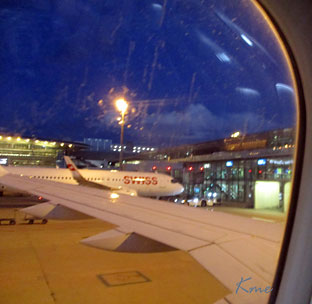| Fra
programmet: (Elite
Travel) Du møter Elite Travels reiseleder på Oslo Lufthavn og sammen flyr vi til München. Videre med buss til Passau, hvor skipet venter. Kjøreturen tar ca 2,5 timer. Vi sjekker inn og finner oss til rette om bord. Passau ligger der elvene Donau, Inn og Ilz møtes, og kalles derfor gjerne Dreiflüssestadt (byen ved de tre elver). Reiselederen holder et informasjonsmøte før middag. Klokka 19 00 kaster skipet loss og cruiset begynner. Første etappe er kort, og etter bare et par timer kommer vi til Engelhartzell i Østerrike. Her blir vi liggende ved kai til neste dag. |
 Tidlig start på dagen. Vi tok båten klokka 0710 fra Slemmestad. |
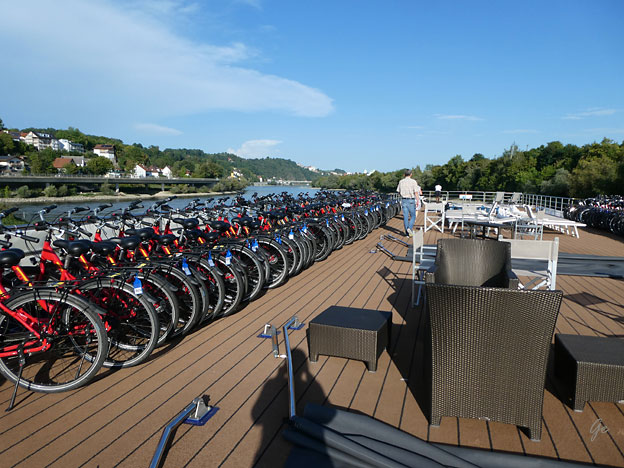
-
Built: 1999 (refurbished in 2019)
-
Flag: Dutch
-
Length: 110 m
-
Beam: 11,4 m
-
Draught: 1,5 m
-
Passengers: 150
-
Crew: approx. 30
- MS
SE-MANON von SE-Tours: Alle Infos,
- Bilder, Ratgeber & buchen - Flusskreuzfahrt Entdecker
 Vi har ankommet Passau, og går ombord i SE-Manon |
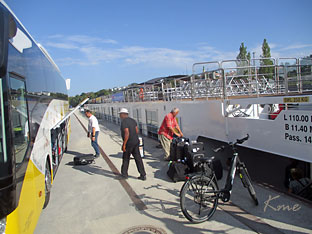 Bagasjen blir også båret ombord. |
Passau (German: Central Bavarian: Båssa) is a city in Lower Bavaria, Germany,
also known as the Dreiflüssestadt ("City of Three Rivers") as the river Danube is
joined by the Inn from the south and the Ilz from the north.
In the 2nd century BC, many of the Boii tribe were pushed north across the Alps
out of northern Italy by the Romans. They established a new capital called
Boiodurum by the Romans (from Gaulish Boioduron), now within the Innstadt
district of Passau.
Many river cruises down the Danube start at Passau and there is a cycling path
all the way down to Vienna. It is on the designated heritage route, the Route of
Emperors and Kings.
Passau is notable for its gothic and baroque architecture. The city is dominated
by the Veste Oberhaus and the Veste Niederhaus, both parts of the former fortress
of the Bishop, on the mountain crest between the Danube and the Ilz.
Passau - Wikipedia
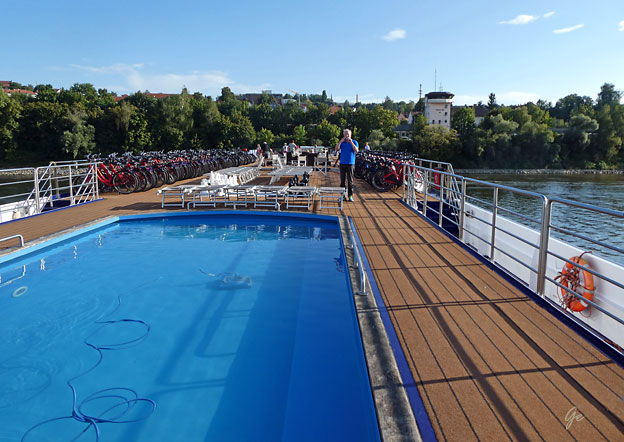
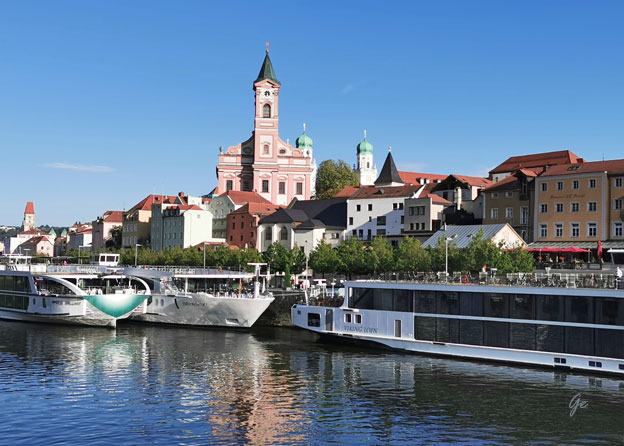
St. Paul og St. Stephan kirkene (St. Stephan med grønne kupler)
The church "St. Paul" marks the entrance to Passau's old town. The baroque
building sits enthroned on a rock on the northern edge of the Roman wall.
The impressive building with its pink and creamy-white colours is often confused
with St. Stephen's Cathedral. While the cathedral is the mother church of the
eastern Danube area, St. Paul often is called the city's mother church.
Today's
building stock goes back to the years from 1667 to
1678. Once the
church's roof was flat. St. Paul got its spire in
the 19th century and until the
renovation in 1950, it was three times higher than
today.
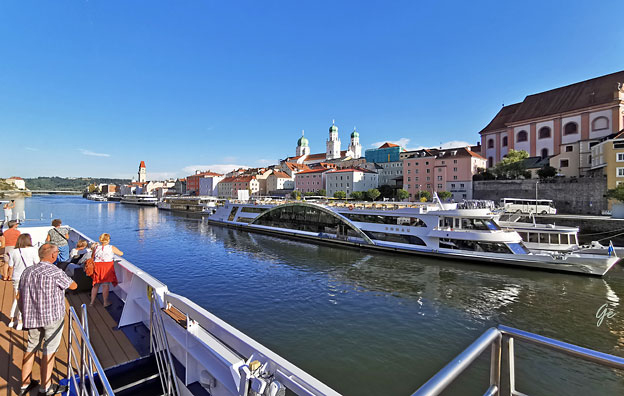
St. Stephen's Cathedral (German: Dom St. Stephan) is a baroque church from
1688 in Passau, Germany, dedicated to Saint Stephen. It is the seat of the Catholic
Bishop of Passau and the main church of his diocese.
Since 730, there have been many churches built on the site of the current
cathedral. The current church, a baroque building around 100 metres (328 ft)
long, was built from 1668 to 1693 after a fire in 1662 destroyed its predecessor,
of which only the late gothic eastern side remains. The cathedral's overall plan
was made by Carlo Lurago, its interior decoration by Giovanni Battista Carlone,
and its frescos by Carpoforo Tencalla.
Passau Cathedral's used to be the largest organ in the world. It still is the largest
church organ outside USA. Over time, it has been outgrown by more recent
instruments, for instance Wanamaker's organ in the USA.
St. Stephen's Cathedral, Passau - Wikipedia
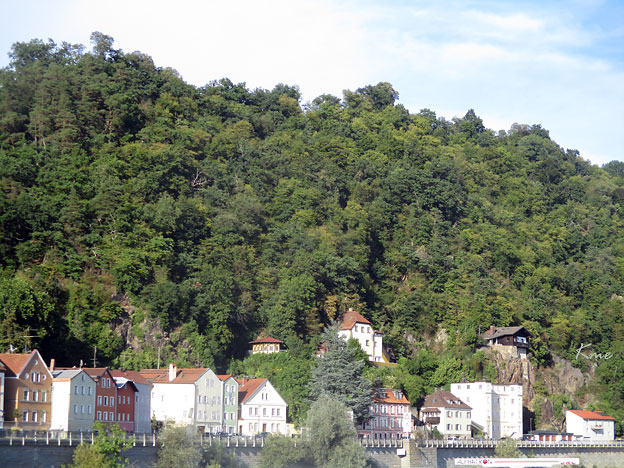
Bratte bakker
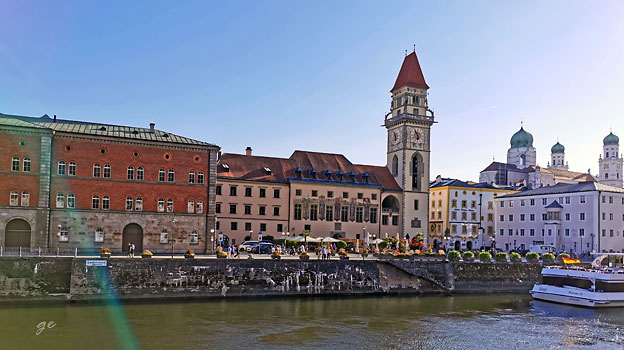
The Town Hall of Passau consists of one large Council Chamber (Großer Rathaussaal)
and one smaller Council Chamber (kleiner Rathaussaal). They are located in the Old
Town Hall, and are accessible via a Gothic staircase dating from 1446.
Following the the devastating Great Fires of 1662 and 1680, this hall was reconstructed
with two naves and three flat casebays by the Italian master builders Carlo Lurago and Giovanni Battista Carlone. Their major influence on Passau’s Italianate Baroque
architecture is honoured by the fact that two picturesque streets near the Cathedral
were named after them: the Luragogasse and the Carlonegasse.
Town Hall Passau | Passau Tourism
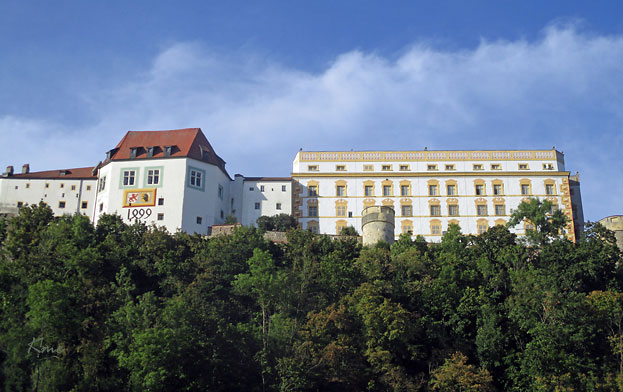
High above Passau the Veste Oberhaus, the former residence of the
prince-bishops and one of the largest surviving castle complexes in Europe,
invites visitors on a journey through the centuries. Within the historic walls
of the fortification the Oberhausmuseum presents exciting exhibitions which
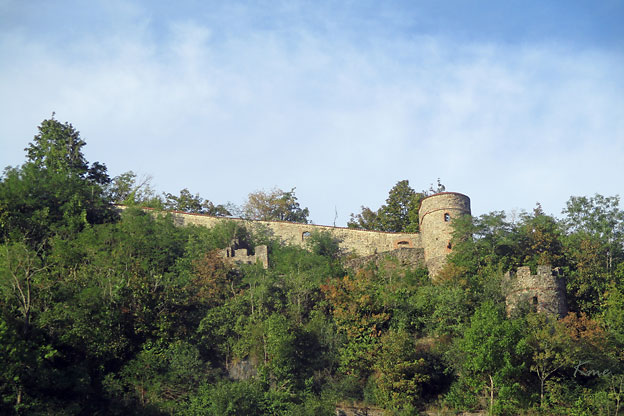
open a window into life in a castle during the Middle Ages and shine a light
on Passau’s colourful history and its importance as a centre of trade over the
centuries.
Fortress Veste Oberhaus Passau | Passau Tourism
Fra programmet:
Etter frokost er vi klar for vår første sykkeltur, som går sørover langs elva,.
Sykkelveien langs Donau er en del av det europeiske sykkelrutenettverket kalt
EuroVelo, Vi skal sykle på EuroVelo 6, som følger Donau fra Tyskland og helt til
Svartehavet. Dette er en av de mest populære turistsykkelrutene i Europa.
Dagens etappe tar oss gjennom området Schlögener Schlinge, der elva gjør en
krapp u-sving, og vi gjør et stopp ved utsiktspunktet for å beundre utsikt over
elven. Vi får med matpakke fra skipet, som vi spiser underveis, Dagens mål er
Untermühl og her venter SE-manon på oss. Resten av ettermiddagen og kvelden
slapper vi av om bord mens skipet seiler videre gjennom Østerrike mot Slovakia.
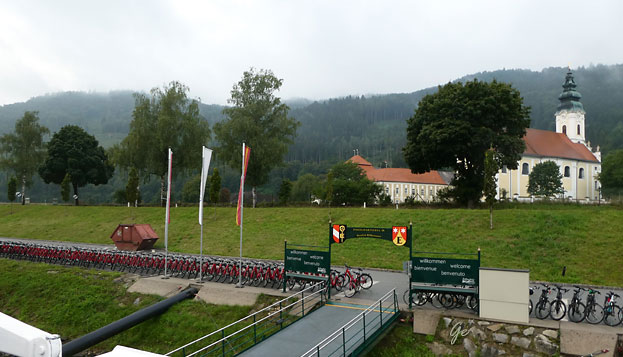
Engelhartzell med kirken Engelszell Abbey
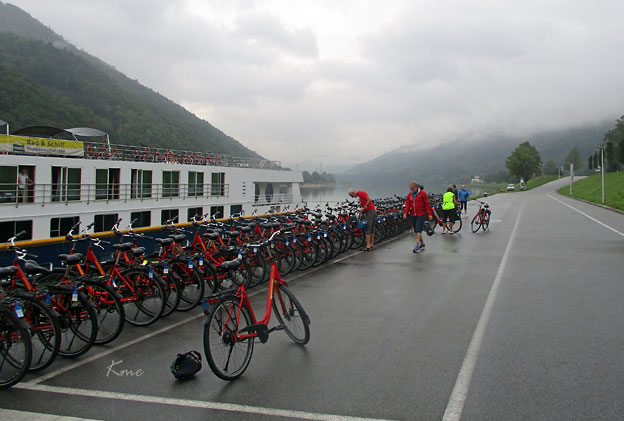
Været var ikke det beste om morgenen, men det ble bedre etterhvert.
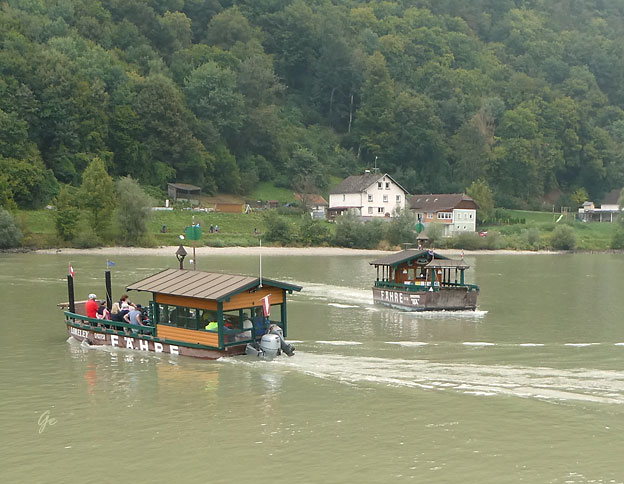
Fra Engelhartzell måtte vi over Donau med ferge.
Den nærmeste ferga heter Loreley
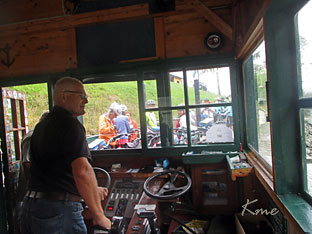 |
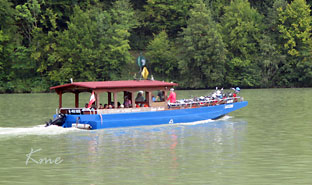 Ved Au måtte vi krysse elva igjen. |
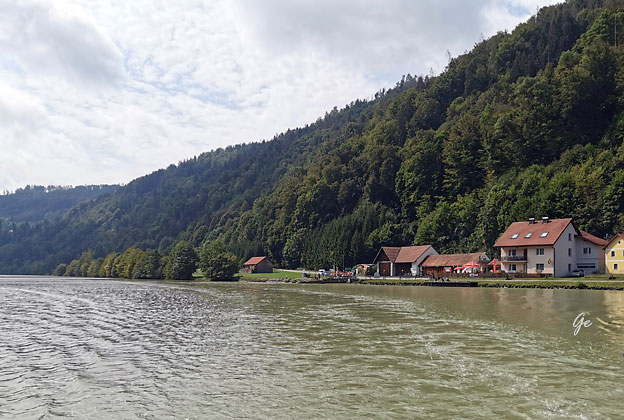
Her spiste vi lunsj. Etter lunsjen ventet en ny fergetur.
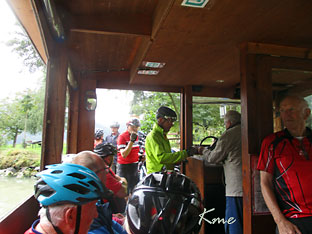 |
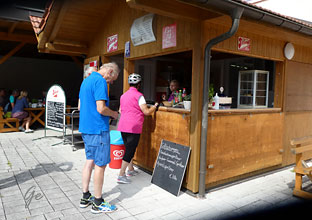 Lunsj ved Kobling |
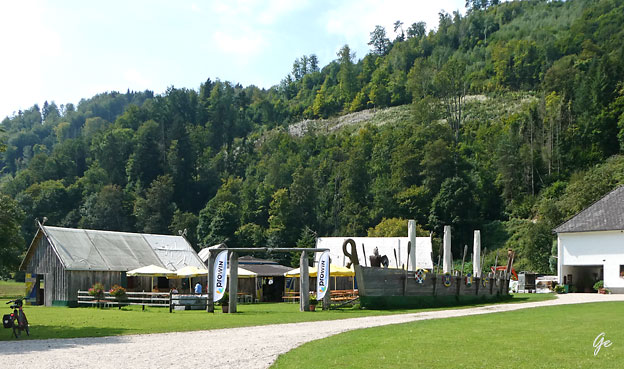
Vikingskip ved Eggenberg.
It flows through much of Central and Southeastern Europe, from the Black Forest
into the Black Sea. Its longest headstream Breg rises in Furtwangen im
Schwarzwald, while the river carries its name from its source confluence in Donaueschingen onwards.
The Danube was once a long-standing frontier of the Roman Empire and today is
the river running through the largest number of countries in the world (10; the
Nile is second with 9). Originating in Germany, the Danube flows southeast for
2,850 km (1,770 mi), passing through or bordering Austria, Slovakia,
draining into the Black Sea. Its drainage basin extends into nine more countries.
The largest cities on the river are Vienna, Budapest, Belgrade and Bratislava,
all of which are the capitals of their respective countries. The Danube passes
through four capital cities, more than any other river in the world. Five more
capital cities lie in the Danube's basin: Bucharest, Sofia, Zagreb, Ljubljana and
Sarajevo. The fourth-largest city in its basin is Munich, the capital of Bavaria,
standing on the Isar River.
Danube - Wikipedia

Vikingskipet Neufundland.
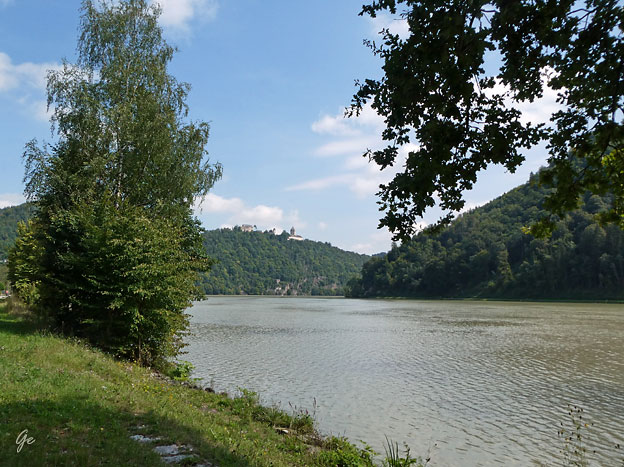
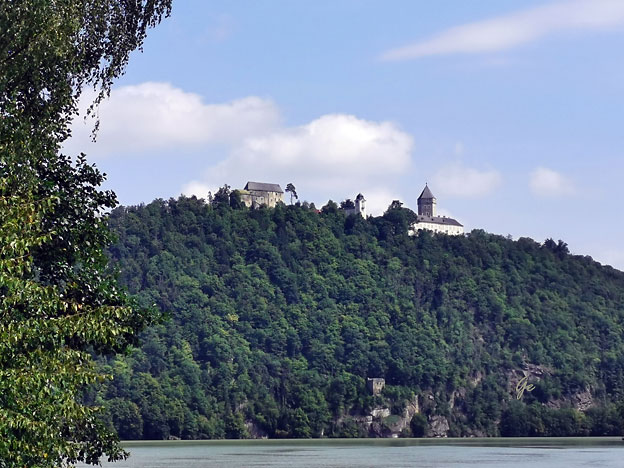
Schloss Neuhaus an der Donau, auch Feste Neuhaus oder
Schloss Neuhaus im Mühlviertel genannt, thront oberhalb des
Ortes Untermühl (Gemeinde Sankt Martin im Mühlkreis) an
der Einmündung der Großen Mühl in die Donau, zwischen der
Schlögener Schlinge und der Marktgemeinde Aschach an
der Donau.
Über die Entstehungszeit der damaligen Burg Neuhaus gehen
die Meinungen der Historiker auseinander. Sie wird ins 12. oder
(wahrscheinlicher) 13. Jahrhundert datiert. Im 12. Jahrhundert
dürfte nur ein festes Haus existiert haben, das den Bischöfen von
Passau als Stützpunkt für die Falkenjagd diente.
An diese Tätigkeit erinnern auch noch die Namen der beiden Streusiedlungen Falkenberg und Falkenbach, die durch den
gleichnamigen Bach getrennt werden.
Schloss Neuhaus an der Donau – Wikipedia
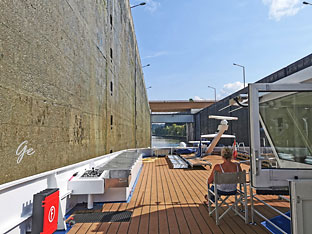 Aschach sluser |
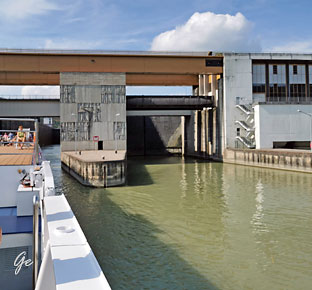 |
Fallhøyden er 16,9 meter.
Bredde 24 meter og lengde 230 meter
Das zugehörige Kraftwerk Aschach liefert maximal 290 MW.
Liste der Schleusen in der Donau – Wikipedia
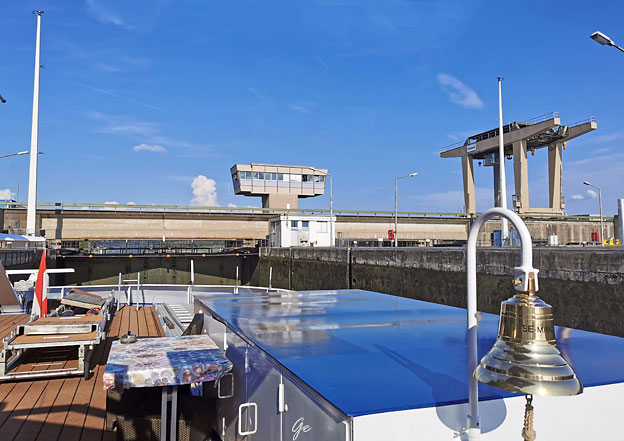
Ottensheim sluser
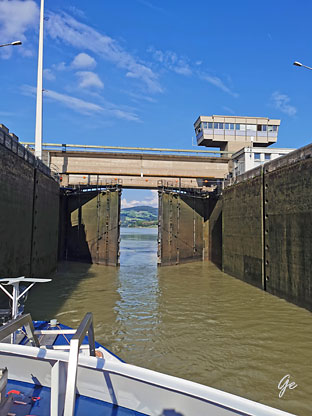 |
Ottensheim sluser har 2 kammer. Fallhøyden er 12,8 meter. Bredde 24 meter og lengde 240 meter. Das zugehörige Kraftwerk Ottensheim-Wilhering liefert maximal 170 MW. Liste der Schleusen in der Donau – Wikipedia |
part of Central Europe, situated at Eastern Alps. It is a federation of nine states,
one of which is the capital Vienna, the largest city and state by population.
The country is bordered by Germany to the northwest, the Czech Republic to the north, Slovakia to the northeast, Hungary to the east, Slovenia and Italy to the
south, and Switzerland and Liechtenstein to the west. It occupies an area of 83,879 km2 (32,386 sq mi) and has a population of 9 million people.
Austria is a parliamentary representative democracy with a popularly elected
president as head of state and a chancellor as head of government and chief executive. Major urban areas include Vienna, Graz, Linz, Salzburg and Innsbruck. Austria is
consistently listed as one of the richest countries in the world by GDP per capita, one
of the countries with the highest standard of living, and was ranked 25th in the
world for its Human Development Index in 2021.
Austria has been a member of the United Nations since 1955 and of the European
Union since 1995. It plays host to the OSCE and OPEC and is a founding member of the OECD and Interpol. It also signed the Schengen Agreement in 1995,
and adopted the euro currency in 1999.
Austria - Wikipedia
Fra programmet:
Om morgenen ankommer vi Bratislava, hovedstaden i Slovakia.
Bratislava var en del av det habsburgske monarkiet fra 1500-tallet
og til slutten av første verdenskrig. Byen var også ungarsk
kroningsby i nesten tre hundre år.
Dagens sykkeletappe gikk til slottet Hof i Østerrike.
Vi ble ikke med på sykkelturen.
Siden vi ikke hadde vært i Bratislava før, ville vi
heller se mer av den byen.
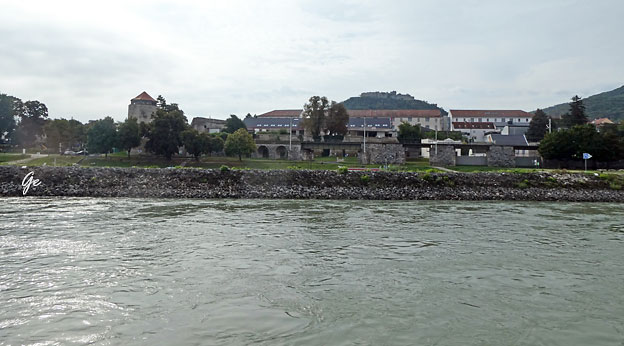
Hainburg an der Donau is a town in the Bruck an der Leitha district,
Lower Austria, Austria.
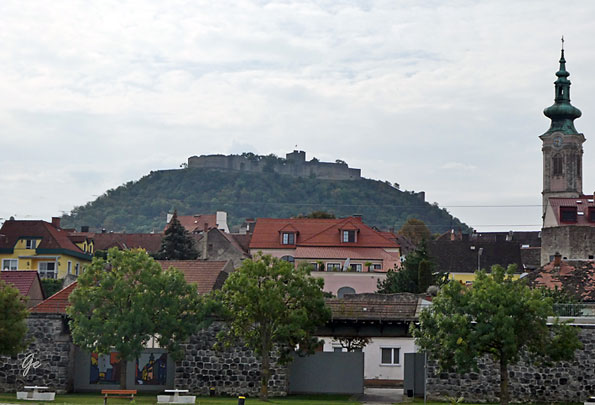
oder zur Hallstattzeit aufgrund der strategisch hervorragenden Lage. Das heutige
Stadtgebiet lag im Einzugsgebiet von Carnuntum, der Hauptstadt der römischen Provinz Pannonien, in der zeitweilig auch Mark Aurel residierte.
Die erste schriftliche Nennung erfolgte im Nibelungenlied im Zusammenhang mit
Rüdiger von Bechelaren.
Kaiser Heinrich III. verfügte um 1050, auf dem Schlossberg die Heimenburg zu bauen.
Erbaut wurde sie schließlich von Bischof Gebhard III. von Regensburg,
Herzog Konrad I. von Bayern und Markgraf Adalbert dem Siegreichen.
Mit seinen 2,5 km langen Stadtmauern, drei erhaltenen Toren und 15 Türmen aus
dem 13. Jahrhundert besitzt Hainburg eine der ältesten und am besten erhaltenen Stadtbefestigungen Europas.
1108 kam die Burg in den Besitz der Babenberger. In der zweiten Hälfte des 12.
Jahrhunderts wurde die Burg durch das Lösegeld für Richard Löwenherz erweitert.
Um 1220–1225 wurde die Befestigungsanlage noch verstärkt. Unter anderem wurde das Wienertor und damit das größte mittelalterliche Stadttor Europas gebaut.
Der untere Teil wurde in der ersten Hälfte des 13. Jahrhunderts gebaut, der obere
Teil 1267/68 durch Ottokar II. von Böhmen.
Hainburg an der Donau – Wikipedia
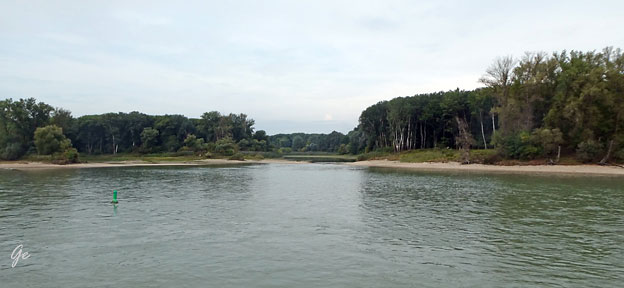
It is bordered by Poland to the north, Ukraine to the east, Hungary to the south,
Austria to the southwest, and the Czech Republic to the northwest. Slovakia's mostly
mountainous territory spans about 49,000 square kilometres (19,000 sq mi),
with a population of over 5.4 million. The capital and largest city is Bratislava,
while the second largest city is Košice.
The Slavs arrived in the territory of present-day Slovakia in the fifth and sixth
centuries. In the seventh century, they played a significant role in the creation of
Samo's Empire. In the ninth century, they established the Principality of Nitra, which
was later conquered by the Principality of Moravia to establish Great Moravia.
In the 10th century, after the dissolution of Great Moravia, the territory was
integrated into the Principality of Hungary, which would then become the Kingdom
of Hungary in 1000. In 1241 and 1242, after the Mongol invasion of Europe, much of
the territory was destroyed. The area was recovered largely thanks to Béla IV of
Hungary, who also settled Germans, leading them to become an important ethnic
group in the area, especially in what are today parts of central and eastern Slovakia
Slovakia - Wikipedia
Devín Castle (Slovak: hrad Devín [ˈɦrad ˈɟeʋiːn] or Devínsky hrad [ˈɟeʋiːnski ˈɦrat], Hungarian: Dévényi vár, German: Burg Theben) is a castle in Devín,
which is a borough of Bratislava, the capital of Slovakia.
The site has been settled since the Neolithic Age and fortified since the Bronze
and Iron Age and later by Celts and Romans.
The cliff (elevation 212 meters) is an ideal place for a fort due to its position
at the confluence of the Danube and Morava rivers. The fort watches over an
important trade route along the Danube as well as one branch of the Amber
Road.
The castle stands just inside Slovak territory on the frontierbetween Slovakia
and Austria. The border runs from west to east along the Morava River and
subsequently the Danube. Prior to 1989, the Iron Curtain between the Eastern
Bloc and the West ran just in front of the castle. Although the castle was open
to the public, the area surrounding it constituted a restricted military zone
and was heavily fortified with watchtowers and barbed wire. After the Velvet
Revolution the area was demilitarised.
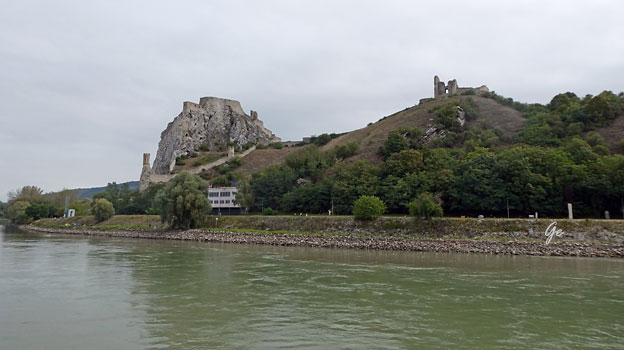
Devin Castle
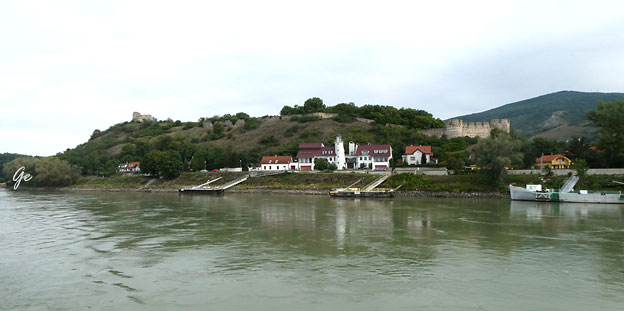
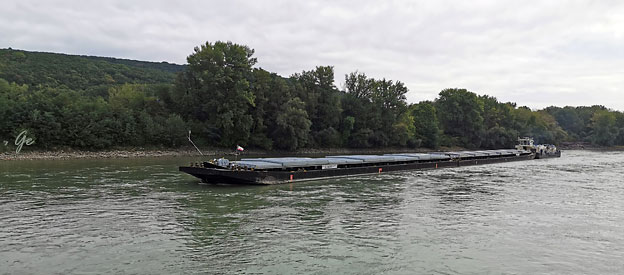
Tungtransport
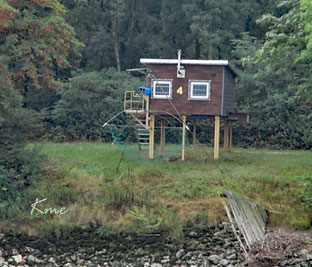 Hytte ved elva. Vi er framme i Bratislava, og mange skal på sykkeltur. |
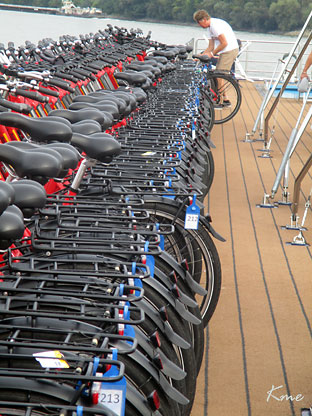 |
the city is about 475,000; however, it is estimated to be more than 660,000 —
approximately 150% of the official figures. Bratislava is in southwestern Slovakia
at the foot of the Little Carpathians, occupying both banks of the River Danube and
the left bank of the River Morava. Bordering Austria and Hungary, it is the only
national capital that borders two sovereign states.
The city's history has been influenced by people of many nations and religions, including Austrians, Bulgarians, Croats, Czechs, Germans, Hungarians, Jews, Romani,
Serbs and Slovaks. It was the coronation site and legislative center and capital of the
Kingdom of Hungary from 1536 to 1783; eleven Hungarian kings and eight queens
were crowned in St Martin's Cathedral. Most Hungarian parliament assemblies were
held here from the 17th century until the Hungarian Reform Era, and the city has been
home to many Hungarian, German and Slovak historical figures.
Today Bratislava is the political, cultural and economic centre of Slovakia. It is the
seat of the Slovak president, the parliament and the Slovak Executive. It has several universities, and many museums, theatres, galleries and other cultural and
educational institutions. Many of Slovakia's large businesses and financial
institutions have headquarters there.
Bratislava - Wikipedia
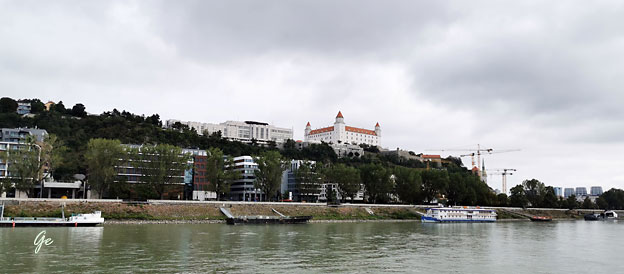
Slottet i Bratislava
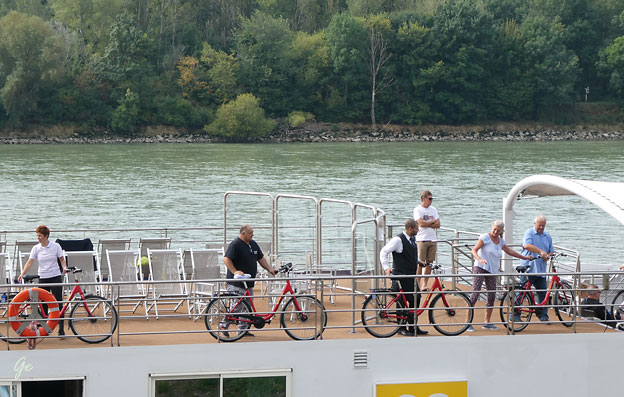
Mange av syklene skal på land.
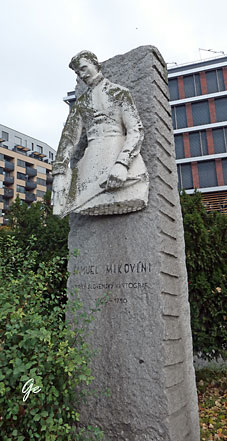 Sámuel Mikoviny (Hungarian: Mikoviny Sámuel, Slovak: Samuel Mikovíni ? – 23 March 1750) was a mathematician, engineer, cartographer, and professor. He was a leading representative of science and technology in the 18th century Kingdom of Hungary and Habsburg monarchy. Sámuel Mikoviny - Wikipedia |
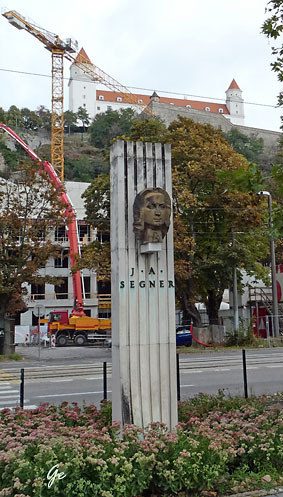 Johann Segner (Hungarian: János András Segner, German: Johann Andreas von Segner, Slovak: Ján Andrej Segner, Latin: Iohannes Andreas de Segner; October 9, 1704 – October 5, 1777) was a Hungarian scientist. He was born in the Kingdom of Hungary, in the former Hungarian capital city of Pozsony (today Bratislava) Johann Andreas Segner - Wikipedia |
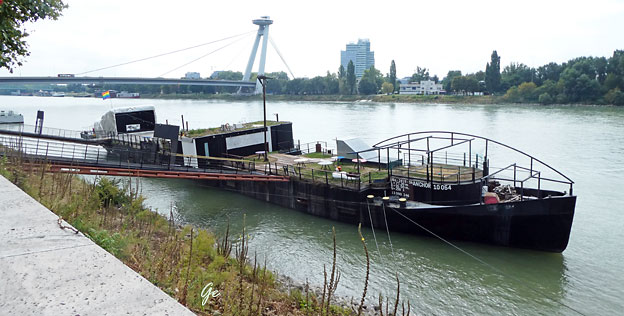 |
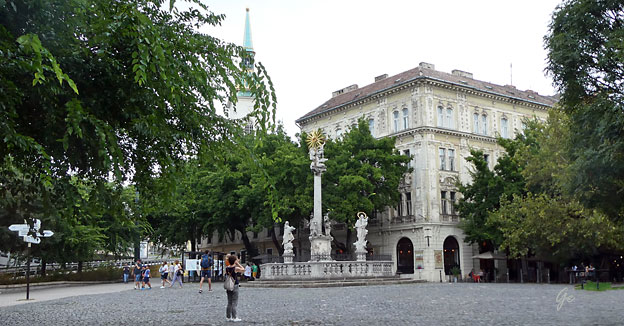 Morový stĺp, Plague Column |
 |
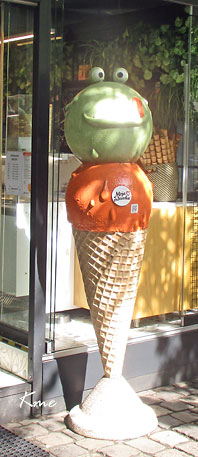 |
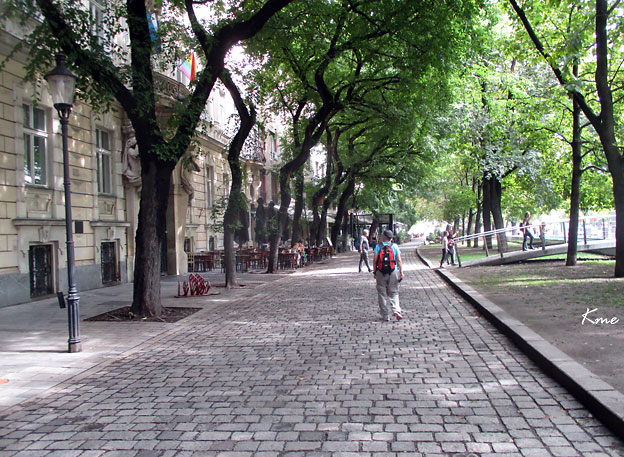
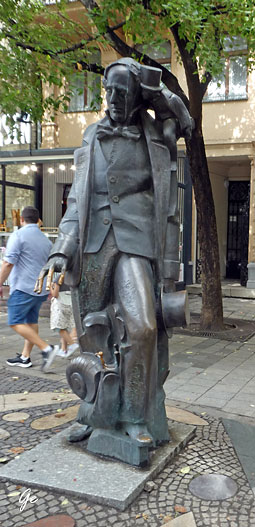 |
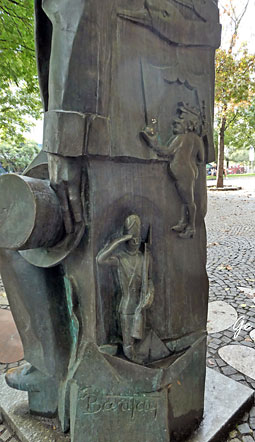 |
det nuværende Bratislava den 3. juni 1841. Han besøgte byen og fandt et teater
og en art “Unter den Linden”, hvor der ikke var mange spadserende, men butikker
som i Pest. Der er ruiner af et gammelt kongeligt slot. Der var en del bygninger,
deroppe under Slottet, som lå højst malerisk. Efter et kort ophold gik rejsen
videre ad Donau til nye rejsemål.
Historien om H.C. Andersen statuen i Bratislava | H.C. Andersen Information (hcandersen-homepage.dk)
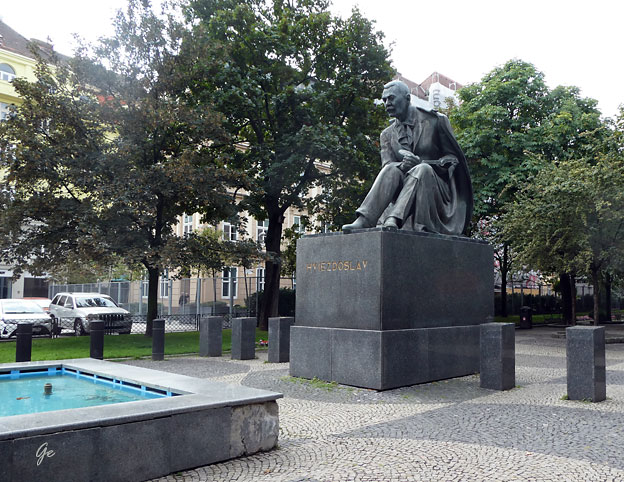 |
| Statue of Hviezdoslav |
Located on Hviezdoslav Square, the Neo-Renaissance structure was built in 1885–1886
during the time of Austria-Hungary, based on a design by the Viennese architects Fellner
& Helmer, who designed theatre buildings in various European cities. It was opened as
the "City Theatre" on 22 September 1886, with the opera Bánk bán by Ferenc Erkel,
which is one of the most important Hungarian operas. As a sign of this event's importance, Kálmán Tisza, then-Hungarian prime minister, and his entire cabinet, as
well as noted Hungarian writer Mór Jókai, attended the ceremony.
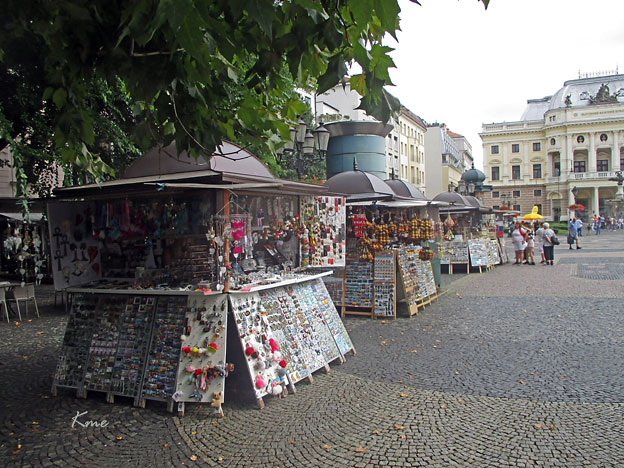
The old Slovak National Theatre building
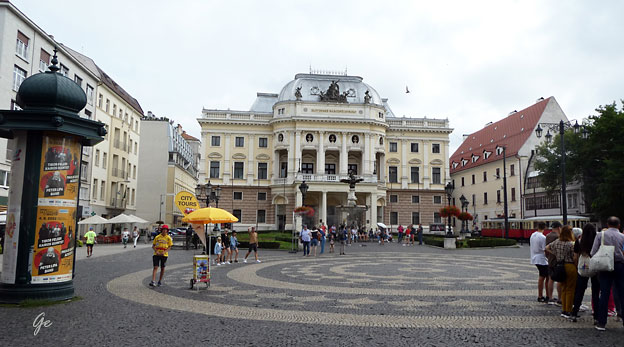
The gala performance was conducted by Ferenc Erkel himself. The original building
was designed for 1,000 spectators and was illuminated using 800 gas lamps, while
the auditorium had a chandelier with 64 lights. The interior was decorated with
frescoes by Pressburg/Pozsony-native painter Kornél Spányik and paintings by
Munich artist Willibald Leo von Lütgendorff-Leinburg, among others.
Austrian sculptor Viktor Oskar Tilgner built the Ganymede fountain located in front
of the theatre in 1888.
Slovak National Theatre - Wikipedia
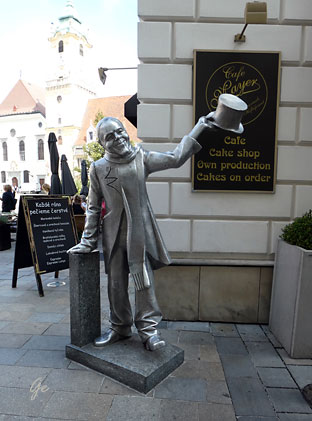 The statue of Schöner Náci by Kaffee Mayer |
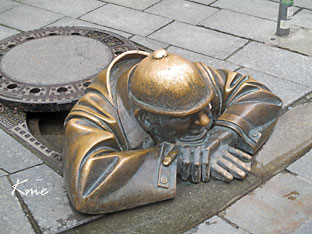 MEET CUMIL, BRATISLAVA’S SOMEWHAT NOTORIOUS sewer worker statue. Is he resting? Is he heading down to clean up your mess? Is he just lurking? The odd statue was installed in 1997 as part of an effort to spice up the look and feel of the area, which was traditionally marked with drab, Communist-era architecture and decoration. Cumil the Sewer Worker – Bratislava, Slovakia - Atlas Obscura |
character (German: Stadtoriginal) of the mid-20th century.
He was born in Petržalka on 11 August 1897 (then Hungary), and died of tuberculosis in Lehnice on October 23, 1967 (then Czechoslovakia). He was originally buried in
Lehnice, but his remains were reburied in Bratislava's Ondrejský cemetery on
September 2, 2007.
Schöner Náci was the son of a shoemaker and grandson of a famous clown, also Ignác Lamár, and was inspired by the latter's example to bring happiness to the streets of the
city. He walked around the Old Town and in particular the stretch from Michael's Gate to the river, in top hat and tails, greeting women with the words, “I kiss your hand” in German, Hungarian and Slovak. He received free food from several of the city's cafes,
and supported himself with occasional cleaning work.
(29. november 2023) Schöner Náci - Wikipedia
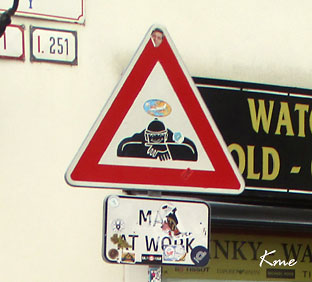 Man at work |
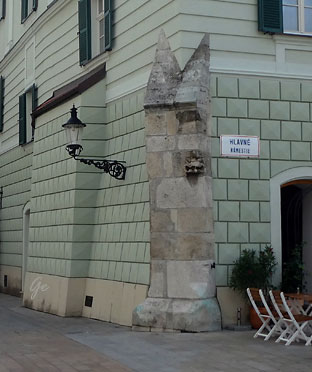 Litt av en gammel mur er synlig på hjørnet. |
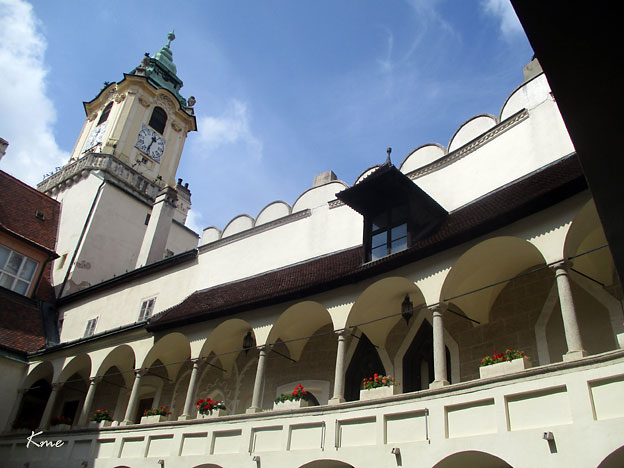
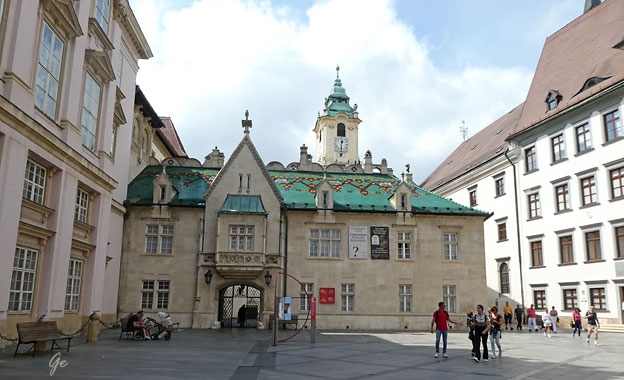
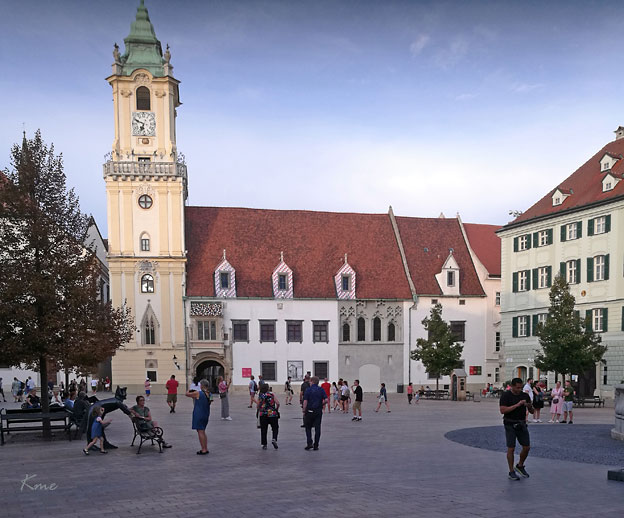
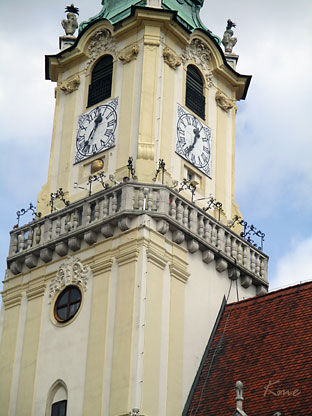 |
The
Jesuit Church of the Holy Saviour, just off Hlavné nám, was built in the 17th century. It's worth peeping inside to see the baroque altar. Jesuit Church | , Slovakia | Sights - Lonely Planet |
Old Town Hall (Slovak: Stará radnica, Hungarian: Régi városháza) is a complex of
buildings from the 14th century in the Old Town of Bratislava, the capital of Slovakia.
It is the oldest city hall in the country and it is one of the oldest stone buildings still
standing in Bratislava, with the tower being built approximately in 1370. The town
hall was created in the 15th century by connecting three townhouses, and then went
through several reconstructions in the course of the centuries.
Old Town Hall (Bratislava) - Wikipedia
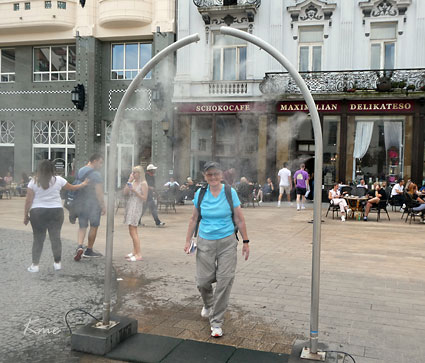 |
To
the wright: Bratislava is chock full of quirky statues, many of which don’t depict the usual historical or famous figures. Napoleon’s Army Soldier is one of these more playful sculptures. The statue was made by Juraj Melis and commemorates two occasions when Napoleon’s army entered the city. |
Napoleon and his army came to Bratislava in December 1805, when 9,000 infantry soldiers and 300 horsemen marched through the streets. While passing through the town, one of the soldiers is said to have fallen in love with a local girl. He decided to stay in Bratislava and began making sparkling wine which he named after himself, Hubert.
The sculpture stands bent over one of the park benches lining the Old Town square.
Napoleon's Army Soldier – Bratislava, Slovakia - Atlas Obscura (29. november 2023)
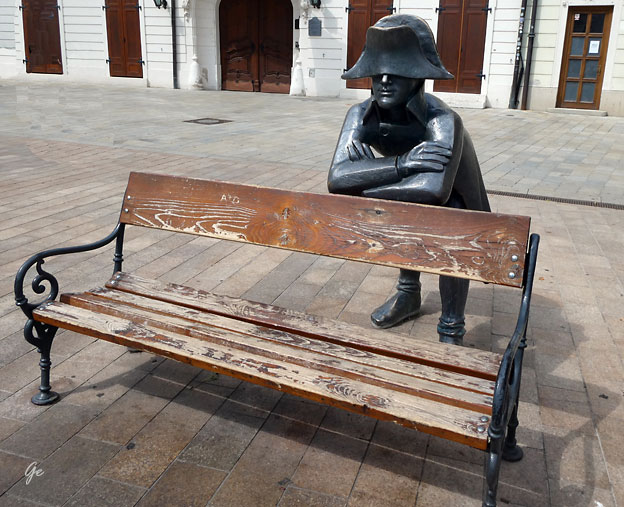
Napoleon’s Army Soldier
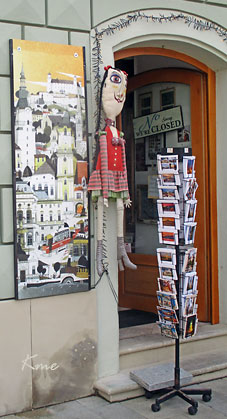 |
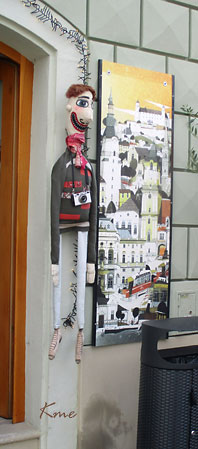 |
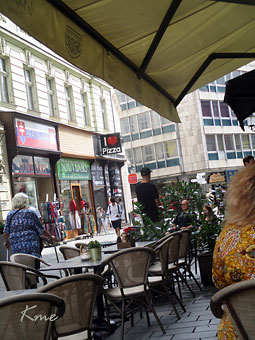 |
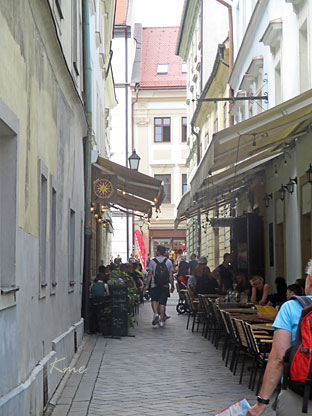 |
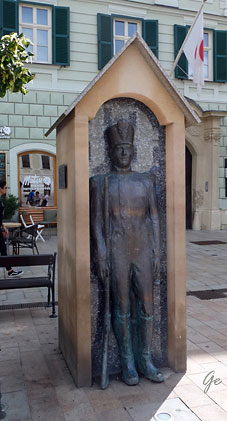 |
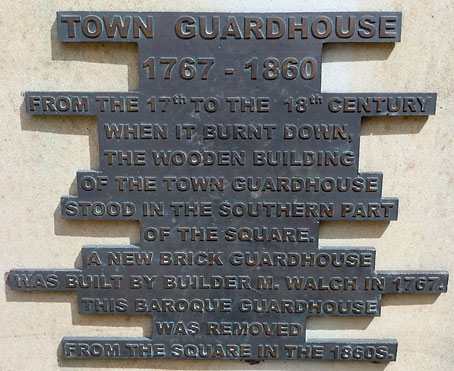 |
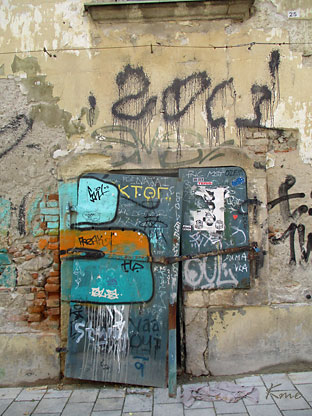 |
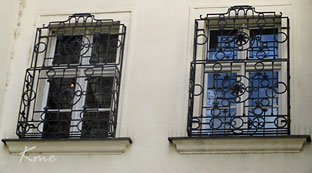 |
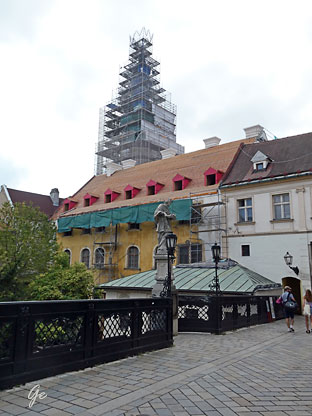 |
In Bratislava, Slovakia, Michael's
Gate (Slovak: Michalská
brána, German: Michaelertor, Hungarian: Mihály kapu) is the only city gate that has been preserved of the medieval fortifications and ranks among the oldest town buildings. Built about the year 1300, its present shape is the result of baroque reconstructions in 1758, when the statue of St. Michael and the Dragon was placed on its top. The tower houses the Exhibition of Weapons of Bratislava City Museum. Michael's Gate - Wikipedia |
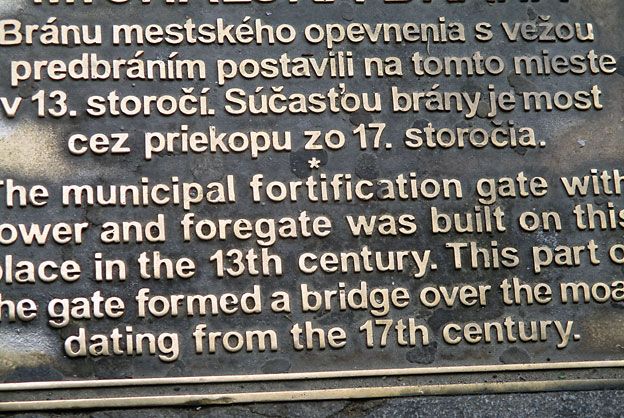
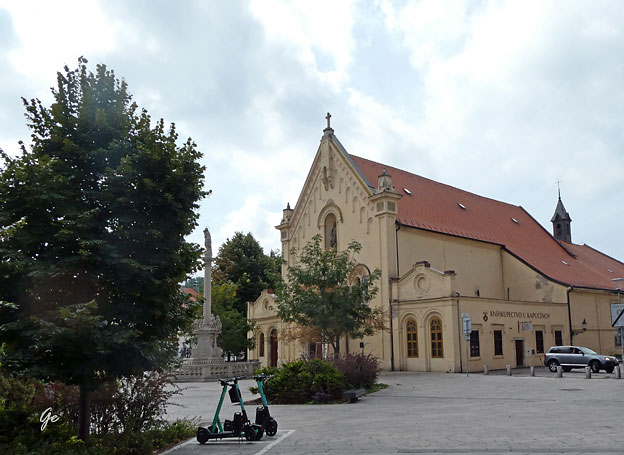
Kostol sv. Štefana Uhorského (kapucíni, Ká-čko)
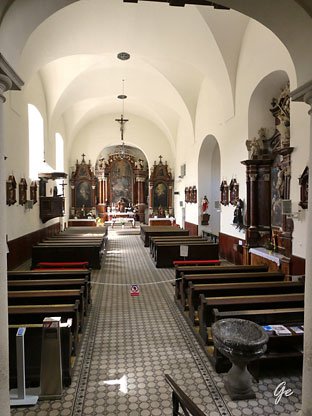 |
Kostol
sv. Štefana Uhorského (kapucíni, Ká-čko) Church of St Stefan |
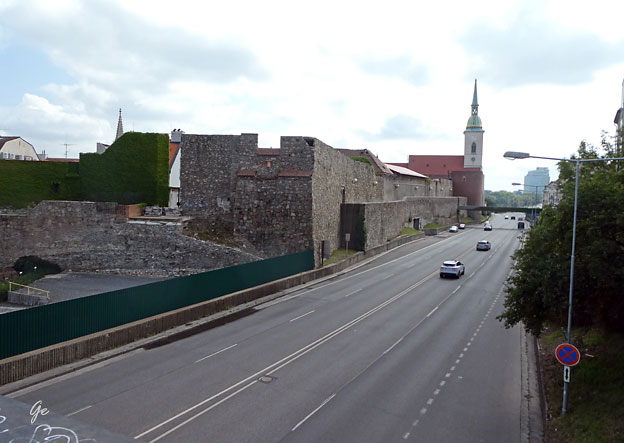
 |
A
simple memorial dedicated to Raoul Wallenberg
(1912-1947?), the Swedish diplomat who saved thousands of Hungarian Jews in Budapest during the Holocaust and was murdered by the Soviets, was erected by the Slovak branch of the International Council of Christians and Jews. JEWISH BRATISLAVA, SLOVAKIA: Jewish museum, synagogue, Chatam Sofer memorial, Jewish community |
The medieval city fortifications are the system of fortifications of the city of Bratislava,
the capital of Slovakia, of which one gate and two sections of walls remain today. Most of the medieval fortification system was demolished in the year 1775 by the order of Empress Maria Theresa of Austria, the rest being torn down in the 18th and 19th centuries. The only remaining consistent stretch of Bratislava city walls running from the St. Martin's Cathedral towards the intersection of Na vŕšku Street and Kapitulská Street is accessible to the public from 2020 again.
Bratislava fortifications - Wikipedia
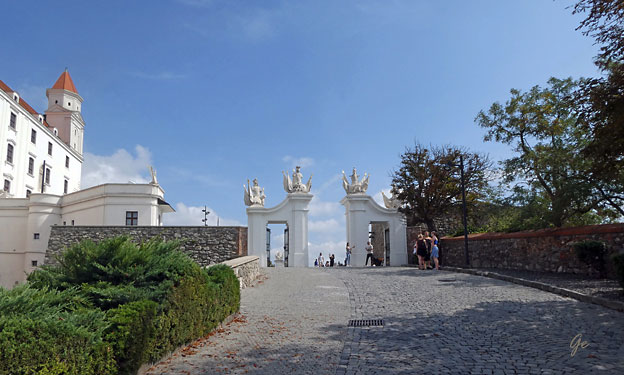
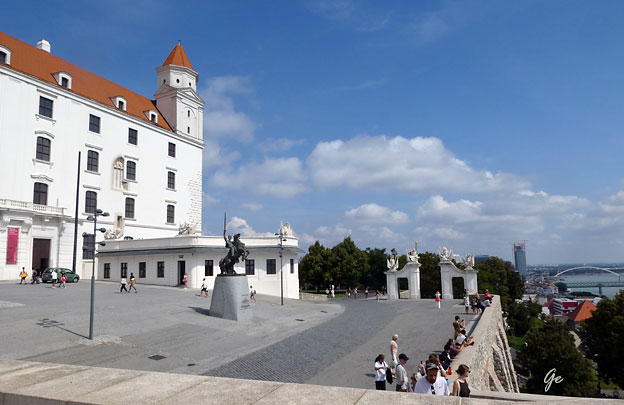
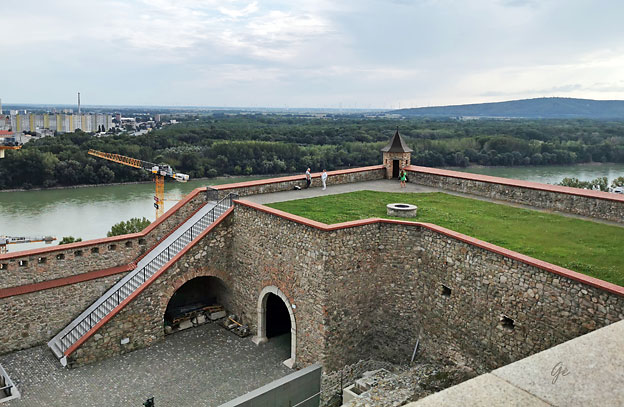
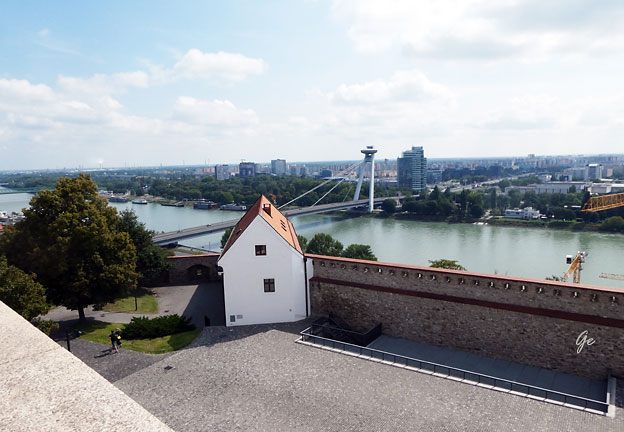
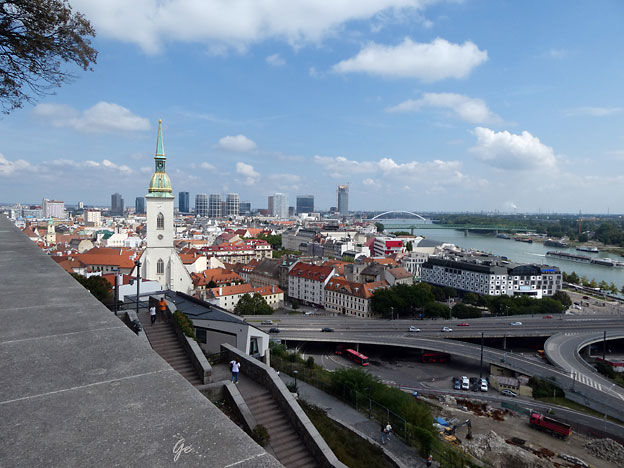
Bratislava sett fra slottet
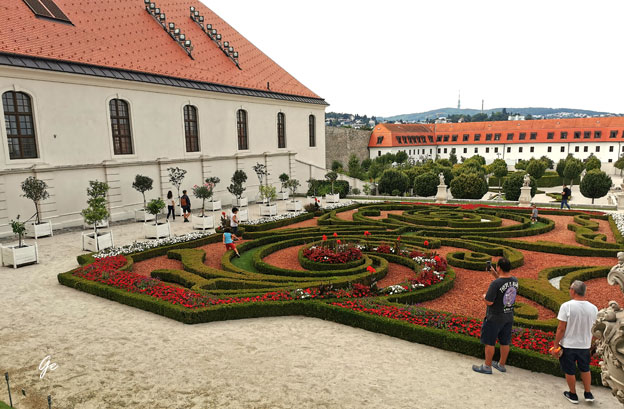
Hagen på slottet
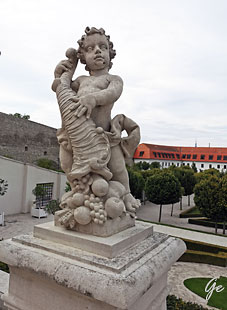 Skulptur i hagen på slottet. |
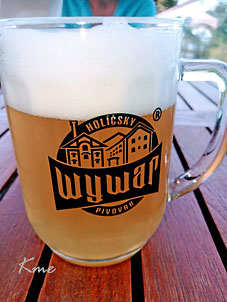 Godt med litt øl i varmen |
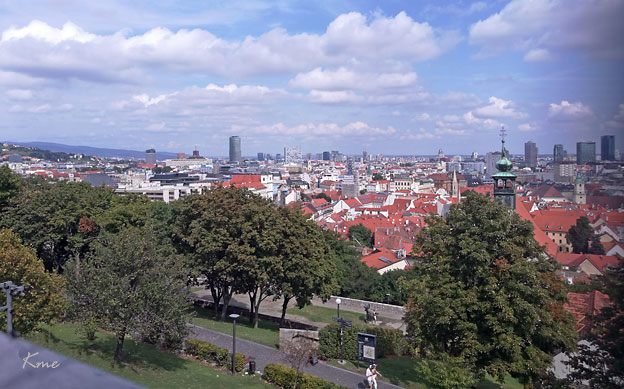
Utsikt fra slottet
Bratislava Castle (Slovak: Bratislavský hrad, IPA: is the main castle of Bratislava,
the capital of Slovakia. The massive rectangular building with four corner towers
stands on an isolated rocky hill of the Little Carpathians directly above the Danube
river in the middle of Bratislava. Because of its size and location, it
has been a dominant feature of the city for centuries.
The location provides excellent views of Bratislava, Austria and, in clear weather,
parts of Hungary. Many legends are connected with the history of the castle.
The castle building includes four towers (one on each corner) and a courtyard
with a 80 m (260 ft) deep water well. The largest and tallest tower is the Crown
Tower on the southwest corner. The 47 m (154 ft) tower dates from the 13th
century and for approximately 200 years beginning in the mid-1500s housed the
crown jewels of Hungary. The exterior walls and inside corridors contain
fragments of old Gothic and Renaissance construction elements. The walled-up
entrance gate from the 16th century is still visible to the east of the main
hall/entrance.
Bratislava Castle - Wikipedia
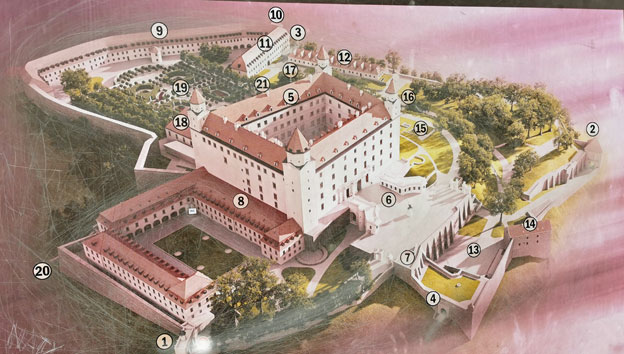
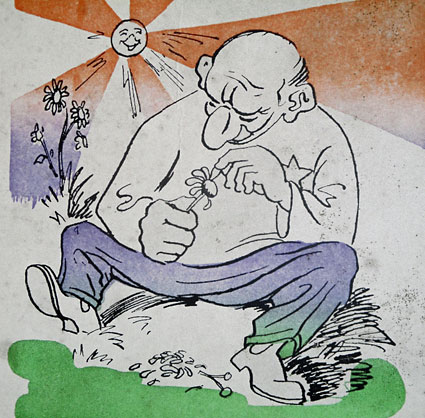 |
Elsker
- elsker ikke |
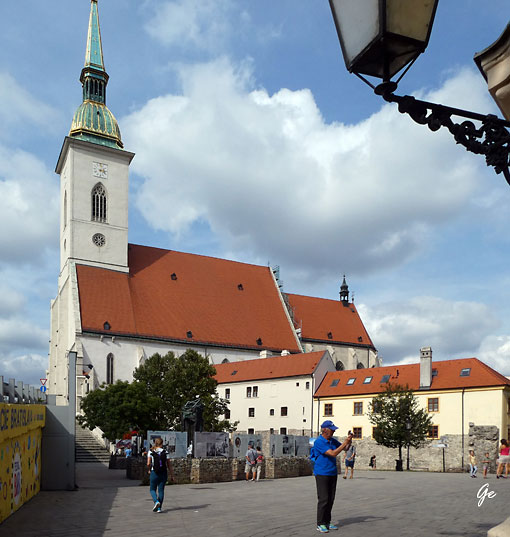 |
St.
Martins Cathedral Bratislava’s three-nave Gothic cathedral is built on the site of a previous, Romanesque church, dedicated to the Holy Saviour, from 1221. After 1291, when Bratislava was given the privileges of a town, the church was rebuilt to become part of the city walls (its tower served as a defensive bastion). The present church was consecrated in 1452. St. Martin's Cathedral | Places | Visit Bratislava |
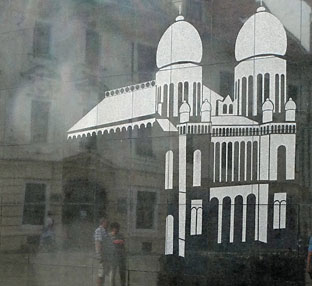 Synagogen fra 1893 |
THE
NEOLOG SYNAGOGUE STOOD ON this site until 1969, it survived World War II only to be demolished to make way for the construction of the SNP Bridge. It was built in 1893 and designed by Dezso Milch as a two-story Moorish building that contained two octagonal onion dome towers. The synagogue was constructed on a square known as Fish Square, adjacent to the city’s St Martin’s Cathedral. Neolog Synagogue Memorial – Bratislava, Slovakia - Atlas Obscura |
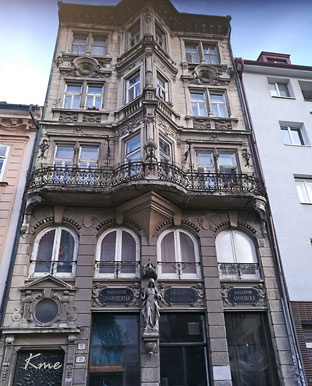 |
bygning
i Bratislava |
Fra programmet:
Vi står tidlig opp for å få med oss innseilingen til Ungarns hovedstad, Budapest.
Mange av byens severdigheter og imponerende byggverk ligger langs elven.
Budapest besto opprinnelig av to byer; Buda og Pest, beliggende på hver sin
side av Dona. I Pest, på østsiden av elven finner man Helteplassen, det vakre
operahuset, St Stefans basilika og parlamentsbygningen i nygotisk stil.
Buda, på vestsiden av Donau, er mer kupert. Her ligger den kjente
Fiskerbastionen med storslått utsikt over byen og elven. I dag er det hviledag
for sykling. Utforsk Budapest i ditt eget tempo eller sammen med reiselederen.
Skipet ligger til kai til over natten.
Det ble ikke hviledag for sykling for alle.
Noen valgte å sykle til en liten by
som het Szentendre, 24 km hver vei.
Vi var blant dem.
Vi hadde vært i Budapest før.
I finværet fristet derfor en sykkeltur langs
Donau mer enn å gå rudt i bygatene.
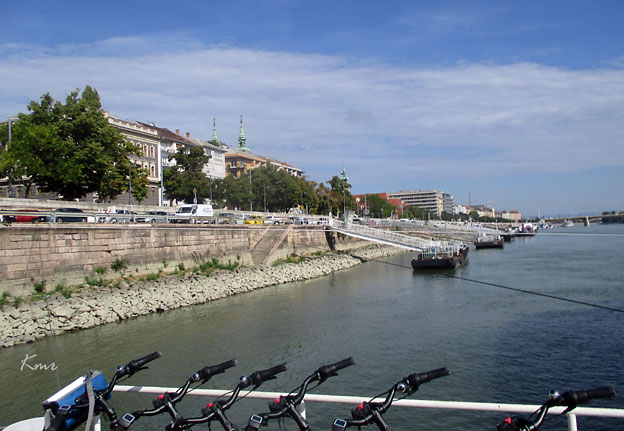
Budapest fra båten. Vi ligger på Pest siden.
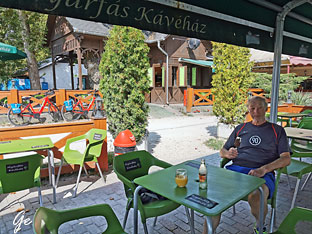 Avslapning i skyggen. Vi er på vei til Szentendre. |
The name of the town is
ultimately based on the Medieval Latin form Sankt Andrae ("St. Andrew"). Because of the diverse mix of nationalities to have once settled in Szentendre, the settlement has a variety of names according to language. The Hungarian name for the town is Szentendre; the Croatian name is Senandrija; the German name is Sankt Andrä; in Serbian, the name is Sentandreja (Serbian |
| Cyrillic: Сентандреја);
the Slovak name is Svätý Ondrej. Its name (Sanctus Andreas) first appeared in a student’s will in 1146, which was confirmed by King Géza II. The 12th-century city centre was situated around the still existing St. Andrew’s Church on the other side of the Bükkös Brook. The area where Szentendre is today was uninhabited when the Magyars arrived. In the 9th century, Árpád's companion, the sacral prince Kurszán, settled here. He renovated the Roman fortress that had fallen into |
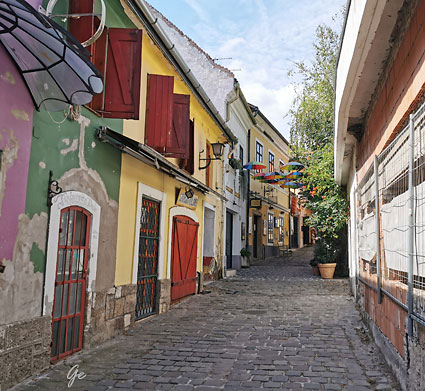 |
Szentendre - Wikipedia
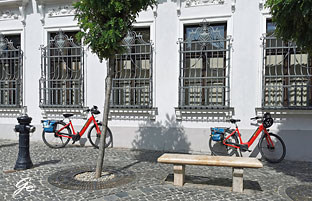 Syklene vi brukte på cruiset står pent parkert mens vi spiser lunsj. Til høyre: Annunciation Church or Blagovestenska Church in Szentendre is a Serbian Orthodox church in Hungary. Annunciation Church, Szentendre - Wikipedia |
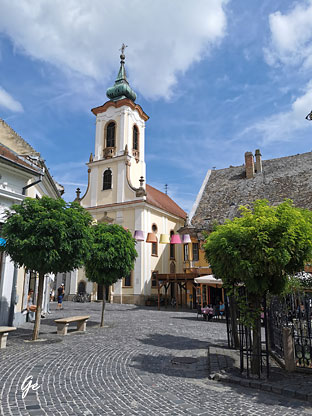 |
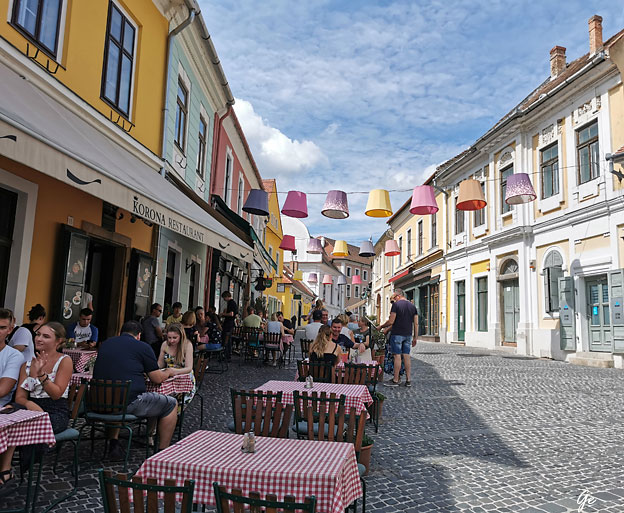
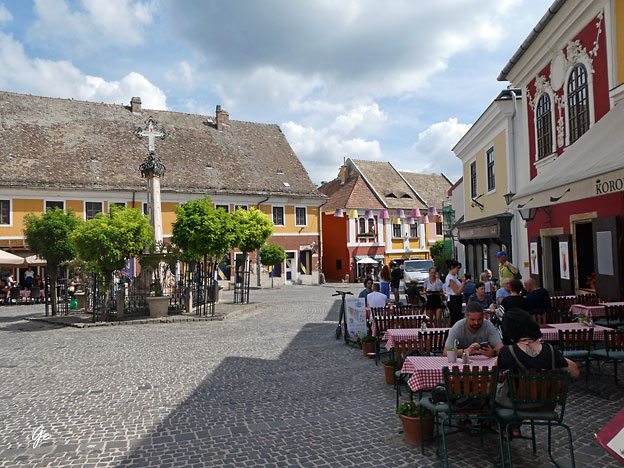

Fine badestrender langs Donau. Karl Martin fikk seg et bad her.
city in the European Union by population within city limits and the second-largest
city on the Danube river;the city has an estimated population of 1,752,286 over a
land area of about 525 square kilometres (203 square miles). Budapest, which is
both a city and county, forms the centre of the Budapest metropolitan area, which
has an area of 7,626 square kilometres (2,944 square miles) and a population of
3,303,786, comprising 33% of the population of Hungary.
The history of Budapest began when an early Celtic settlement transformed into the Roman town of Aquincum, the capital of Lower Pannonia. The Hungarians
arrived in the territory in the late 9th century, but the area was pillaged by the
Mongols in 1241–42. Re-established Buda became one of the centres
of Renaissance humanist culture by the 15th century. The Battle of Mohács, in
1526, was followed by nearly 150 years of Ottoman rule.[26] After the reconquest
of Buda in 1686, the region entered a new age of prosperity, with Pest-Buda
becoming a global city after the unification of Buda, Óbuda and Pest on
17 November 1873, with the name 'Budapest' given to the new capital. Budapest
also became the co-capital of the Austro-Hungarian Empire, a great power that
dissolved in 1918, following World War I. The city was the focal point of the
Hungarian Revolution of 1848, the Battle of Budapest in 1945, as well as the
Hungarian Revolution of 1956.
Budapest - Wikipedia
kilometres (35,920 sq mi) of the Carpathian Basin, it is bordered by Slovakia to
the north, Ukraine to the northeast, Romania to the east and southeast, Serbia
to the south, Croatia and Slovenia to the southwest, and Austria to the west.
Hungary has a population of nearly 10 million, mostly ethnic Hungarians and a significant Romani minority. Hungarian, the official language, is the world's most
widely spoken Uralic language and among the few non-Indo-European languages
widely spoken in Europe. Budapest is the country's capital and largest city; other
major urban areas include Debrecen, Szeged, Miskolc, Pécs, and Győr.
The territory of present-day Hungary has for centuries been a crossroads for
various peoples, including Celts, Romans, Germanic tribes, Huns, West Slavs and
the Avars. The foundation of the Hungarian state was established in the late 9th
century AD with the conquest of the Carpathian Basin by Hungarian grand prince
Árpád. His great-grandson Stephen I ascended the throne in 1000, converting his
realm to a Christian kingdom. By the 12th century, Hungary became a regional
power, reaching its cultural and political height in the 15th century. Following the
Battle of Mohács in 1526, it was partially occupied by the Ottoman Empire
(1541–1699). Hungary came under Habsburg rule at the turn of the 18th century,
later joining with the Austrian Empire to form Austria-Hungary, a major power
into the early 20th century.
Hungary - Wikipedia
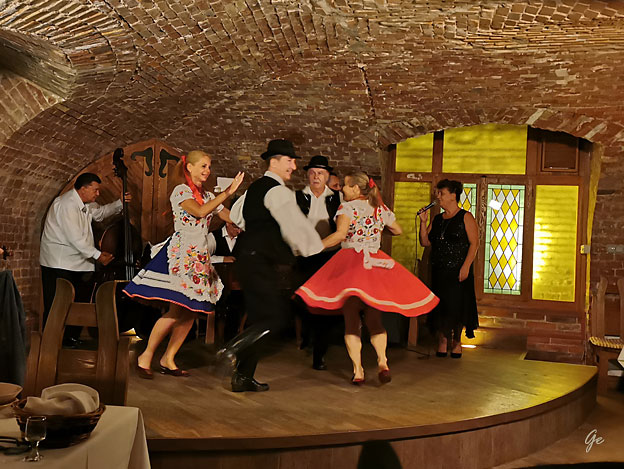
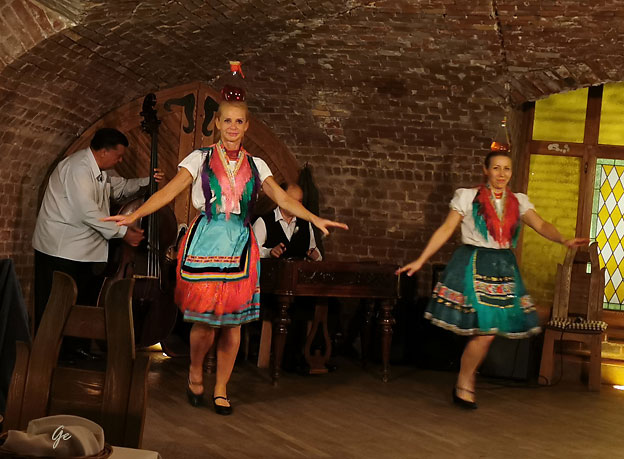
 |
Om
kvelden fikk vi en smak av sigøynermusikk og dans. Vi fikk servert ungarsk brennevin da vi kom, senere fikk vi gulasj-suppe og applestrudel. Vin og vann sto på bordet hele kvelden. Etterpå var vi på busstur i byen for å se belysningen. |
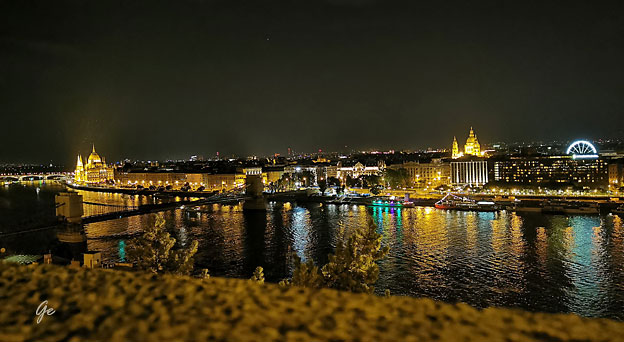
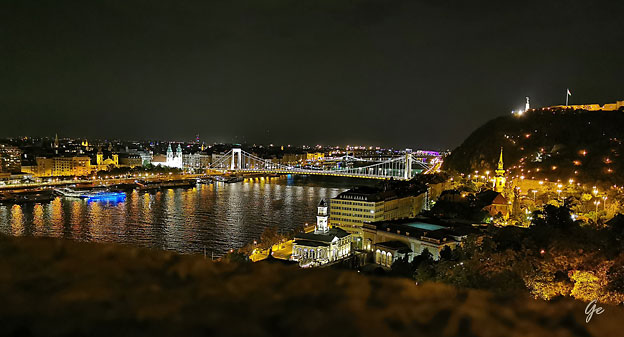
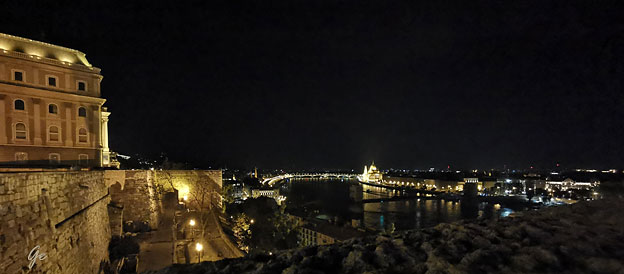
Utsikt fra slottområdet.
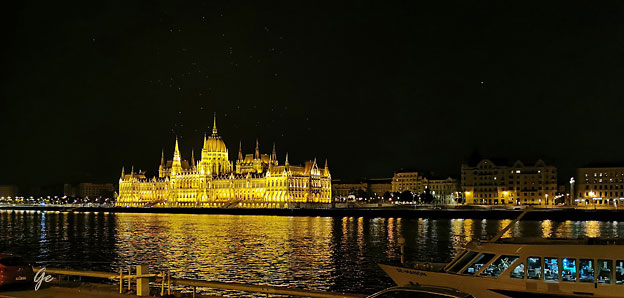
Parlamentsbygningen sett fra lugaren vår.
Det er mer om Budapest her:
Budapest_2016 (emblemsvaag.no)
| Denne
dagen ble det forandring i planene. Vi skulle ha sykla fra Visegrad til Esztergom (Ungarn). Men det var for lite vann i Donau etter lang tørke, så vi kunne ikke legge til der. I steden seilte vi til en liten by som het Komarno, Slovakia. Noen sykla en tur i området rundt byen, andre rusla rundt inne i Komarno. |
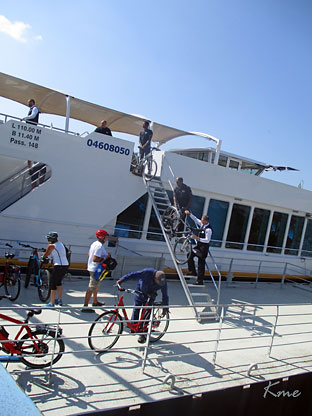 |
hele mannskapet oppi en sykkelstafett.
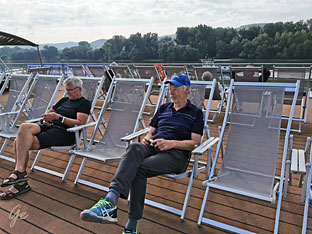 |
Komárno,
is a town in Slovakia at the confluence of the Danube and the Váh rivers. Historically it was formed by the "old town" on the left bank of Danube, present day Komárno in Slovakia, and by a "new town" on the right bank, present day Komárom in Hungary, which were historically one administrative unit. |
independent towns in two countries. Komárno and Komárom are connected by
the Elisabeth Bridge, which used to be an official border crossing between
Slovakia and Hungary until border checks were lifted due to the Schengen Area
rules. In 2020, a new road bridge was opened.Komárno is Slovakia's principal
port on the Danube. It is also the center of the Hungarian community in Slovakia,
which makes up 53.8% (2011 census) of the town's population. The town is the
historic seat of the Serbian national minority in Slovakia.
Komárno - Wikipedia
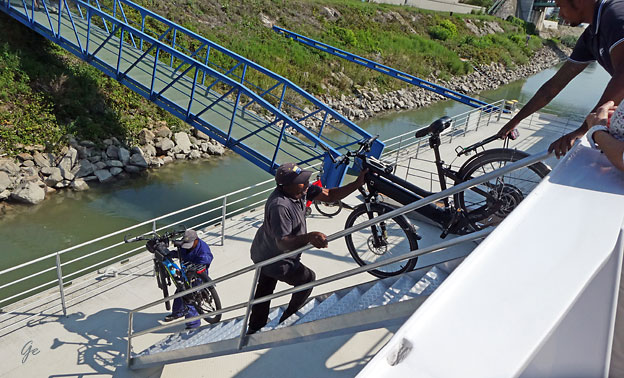
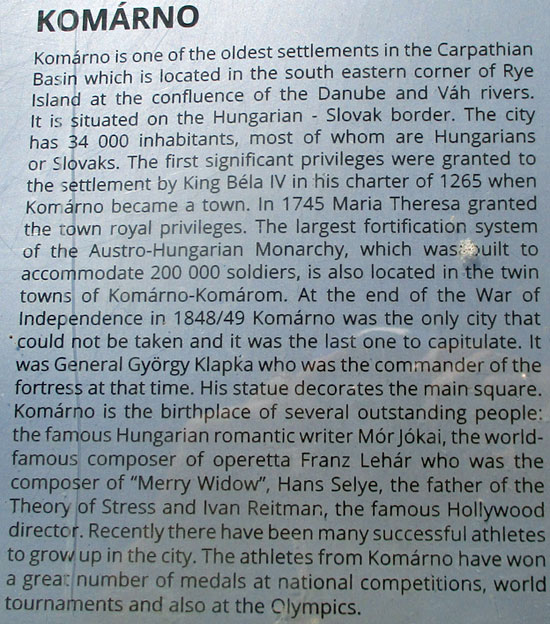

Komarno er en travel havneby.
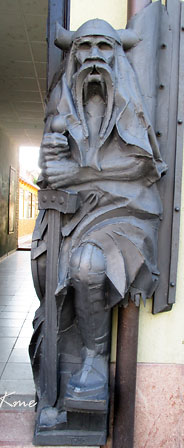 |
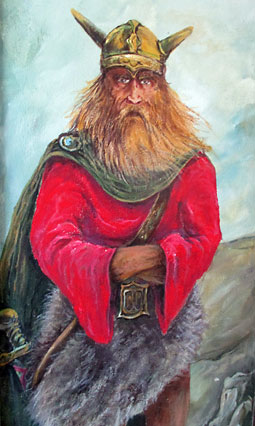 |
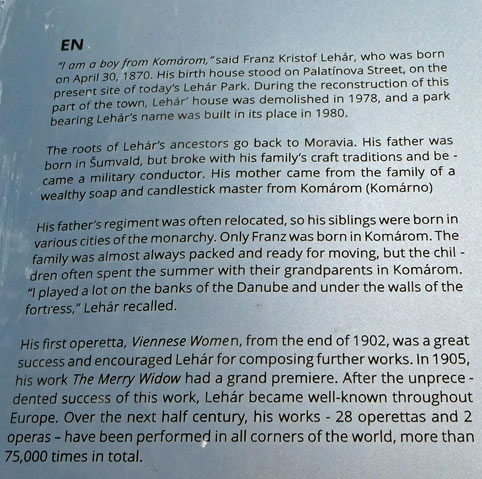 |
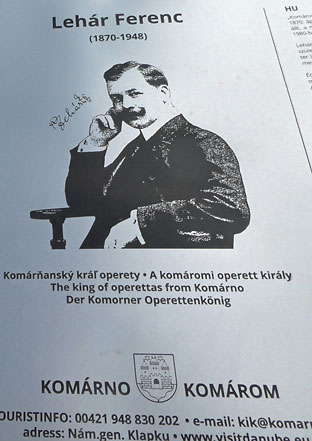 Franz Lehar er født i Komarno. |
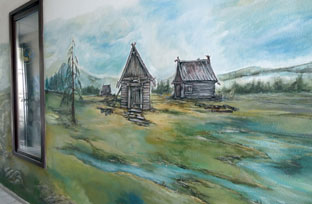 Har det vært vikinger i Komarno? |
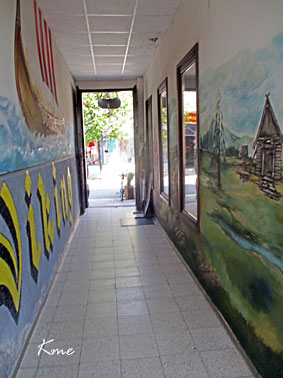 |
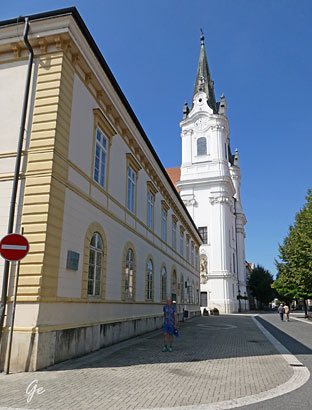 The St. Andrew´s Cathedral |
The
St. Andrew´s Cathedral in Komárno is one of the dominant buildings in the town. It is located on the Palatinova Street, opposite the Danube Museum. It was erected by the Jesuits between 1748-1756. It collapsed during the earthquake of 1763, but in the following years it was rebuilt according to the original plans. In its present form, it was built between 1768 and 1771 in Baroque style. After the suppression of the Jesuits, it fell under the care of the Benedictines. He suffered many fires and natural disasters. It was almost completely destroyed by the great city fire of 1848. It was reconstructed in 1860 from public donations. The church was granted the title ´Basilica´ (basilica minor) in 2018. St. Andreas Cathedral - Details - Dunamente - Podunajsko - Visit Danube Region |
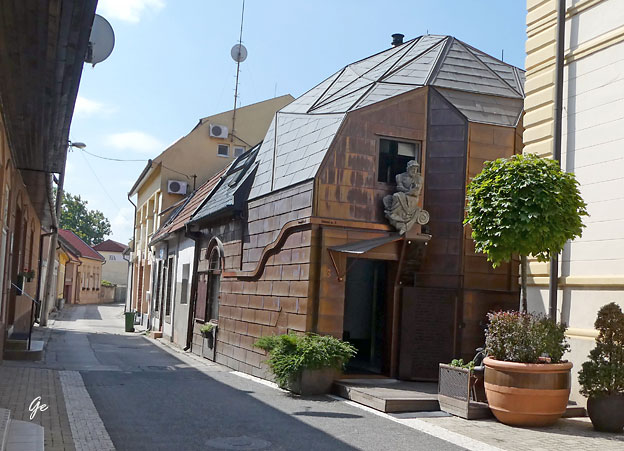
Komarno
The neo-renaissance building of the Komárno town hall dominates the Klapka Square in
the town centre. The original town hall was built on the same place in 18. century, but
was later destroyed during an earthquake. The current building was built in 1875. Main attraction of this historical building is a hussar march, which can be heard every day at 10AM, 12PM, 2PM and 4PM. As the march plays, a small figure of the hussar comes out of
the window on the town hall tower.
(29. november 2023) Komárno Town Hall | Discover Komárno | visitkomarno.eu
Statuen på plassen:
The Klapka Square presents its dominant feature – the statue of György Klapka, a representative of the Hungarian Revolution in 1848-49. In 1849 general Klapka
was in command of defence of Komárno as the last fort of revolutionists against
Austrian imperial army.
(29. november 2023) Town Hall and Klapka squere - Komárno | Kukkonia
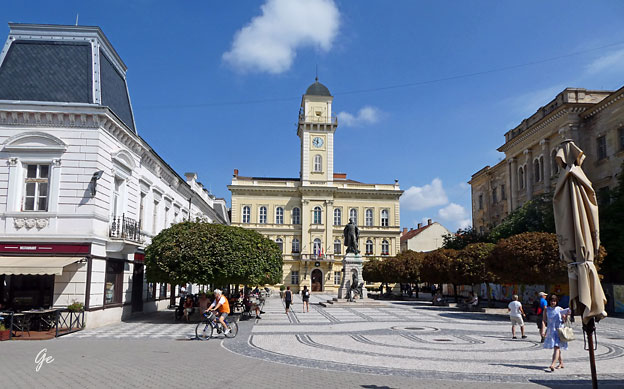
The white house:
The building of the Zichy palace was built on the main square of Komárno, and for
centuries it played an important role in the history of the city, being used as a theater, residence, synagogue, post office, cellar and for various other purposes.
On June 28, 1763, a huge earthquake struck Komarno. As a result of the earthquake,
63 people died, there were 102 injured people, 7 churches and 279 buildings collapsed.
Part of the buildings collapsed, the city buildings were seriously damaged, and only 9%
of the buildings remained intact. Zichy's palace was also damaged by the earthquake. According to the sources, today's building was rebuilt in 1775 by Ferenc Zichy in a
classicist style.
(29. november 2023) Palace Zichy - Details - Dunamente - Podunajsko - Visit Danube Region
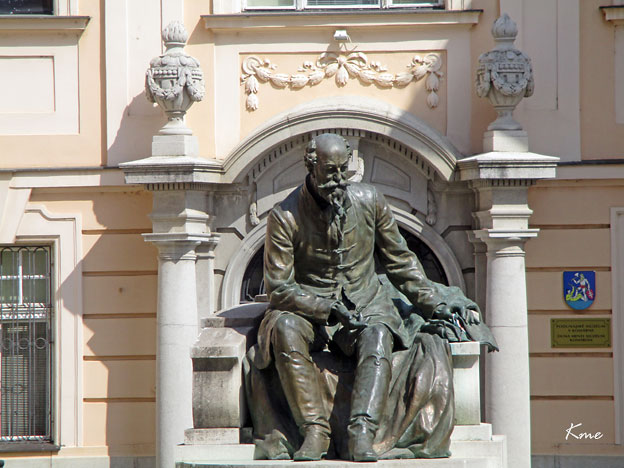
Statue of Jókai Mór, socha Móra Jókaiho
It is the work of Gyula Berecz from 1936 and is a remembrance of the
greatest Hungarian romantic writer, who was born on 18. 02. 1825.
in Komárno.
The statue stands in front of The Danube-Region Museum.
(29. november 2023)
Statue of the Hungarian writer, Mór Jókai - Details - Dunamente - Podunajsko - Visit Danube Region
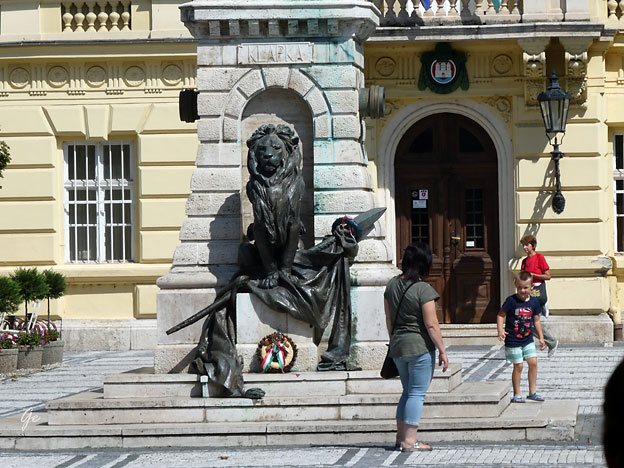
Nedre del av stauen av general Klapka.
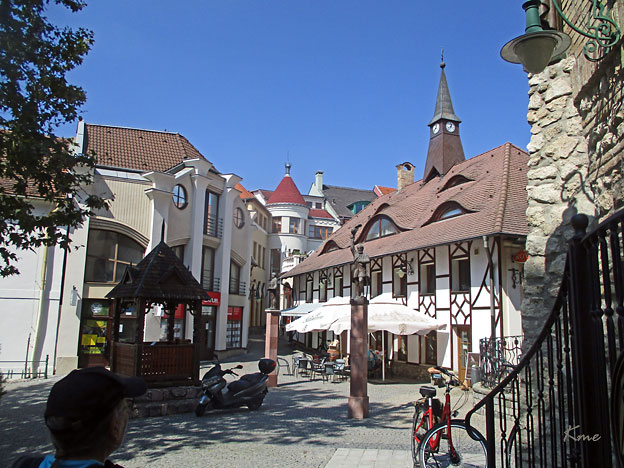
The Courtyard of Europe
The Courtyard of Europe is the name for the unique architectural work of the
architects from the Atelier Europe in Komárno. The buildings in the new
square with a surface of 6,500 m2 are stylistically designed and they represent
historical architecture typical for particular parts of Europe.
The historical centre of Komárno, a town situated in the south of Slovakia, on
the bank of the river Danube, and the Courtyard of Europe are linked by
entrance gates: the gate of St. Stephen, the gate of Belo IV, and the gate of
Mary Theresa.
The gate of Mathew I. opens from the side of the inner park of the Zichy Palace.
Mathew I was the best-known king in our history, who was closely emotionally
connected with the town of Komárno. This gate is one of the landmarks of the
Courtyard. With its shape and colours, it reminds the buildings built during the
reign of Mathew I.
In the middle of the square stands a functional copy of the original well which
used to stand in the main square, in front of the Town Hall until 1878.
The Courtyard of Europe in Komárno - Slovakia.travel
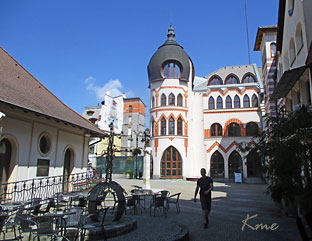 The Courtyard of Europe |
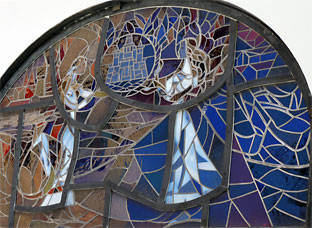 |
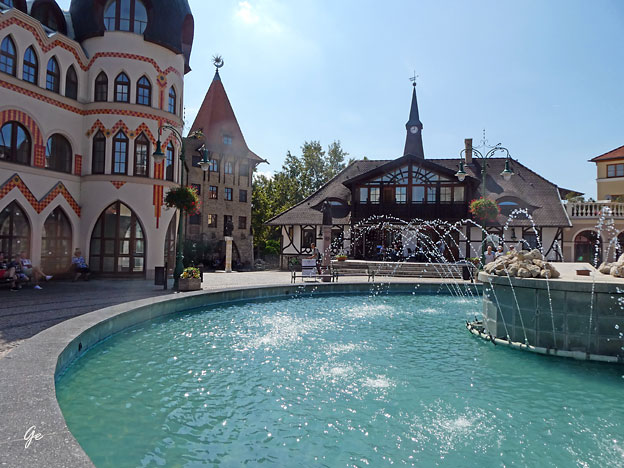
The Courtyard of Europe
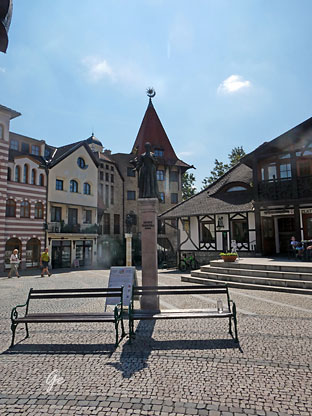 |
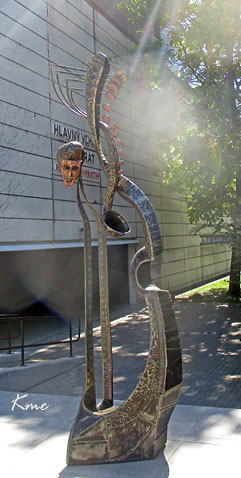 |
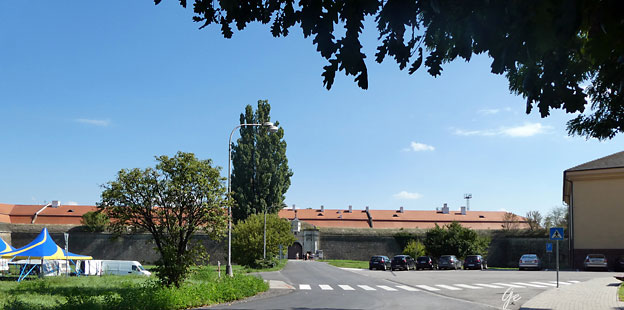
An earthquake in 1783, the epicenter of which was not far from the fortress,
caused extensive damage to the fortress and sealed its fate. The generals of
that time decided to give up the fortress because repairs were no longer
worthwhile. The site of the fortress was donated to the city by Emperor
Joseph II and the buildings were sold at auction in 1784 to the highest bidder.
In 2003, the city of Komárno bought the Old and New Fortresses in order to
carry out appropriate reconstruction work and thus preserve the historical
ambience and make the object accessible to the public. (Open 2022)
Fortress of Komárno - Wikipedia
The fortress is located in today's urban area of Komárno on the left bank
of the Danube, which has belonged to Czecho-Slovakia (today's Slovakia)
since 1920.
It had great strategic importance in the past and was the largest fortress in
what was then Austro-Hungarian Empire.
During the period of Turkish expansion in the 16th century, the city of
Komárno fell into the border area of the Habsburg and Ottoman empires.
The construction of the so-called "old" fortress began in 1546 on the
foundations of a medieval castle according to plans by the Italian master
builder Pietro Ferrabosco and the Alsatian Daniel Specklin.
The fortress was built at the confluence of the Danube and Váh rivers
to provide protection against further Turkish advances into Habsburg-ruled
Hungary.
In 1526 the Ottoman Empire invaded Hungary. In the Battle of Mohács on
August 29, 1526, the Hungarian army was crushed by the Turks. The fortress
proved itself when in 1594 the Ottomans tried unsuccessfully to take the city
of Komárno with an army of 100,000 men. Between the years 1673 and 1683
the fortress was strengthened. The Old Fortress had five bastions and two
inner courtyards surrounded by casemate-like structures designed to house
the guards. The fortress was surrounded by a moat. And there was only one
access to the fortress through the so-called Ferdinand Gate.
Fortress of Komárno - Wikipedia
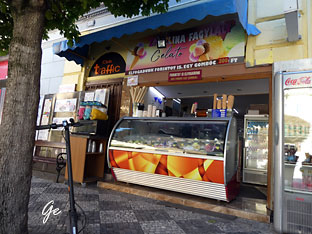 |
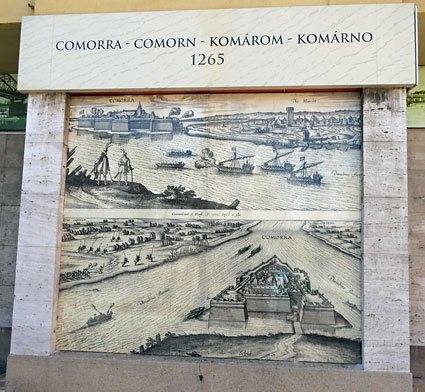 |
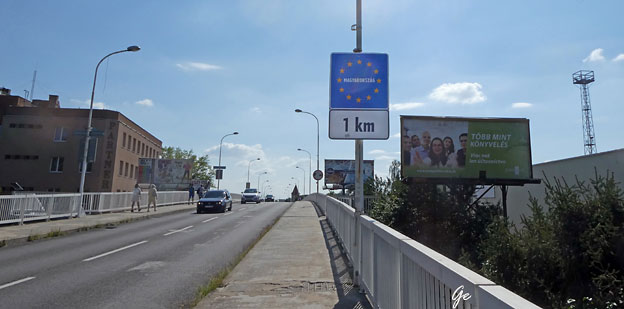
Bare 1 km over til Ungarn
Fra programmet:
Ved lunsjtid legger vi til kai i Nussdorf (ellerKorneuburg), en av forstedene til Wien.
Det er ingen sykkeltur i dag. Benytt i stedet ettermiddagen til å oppleve Østerrikes hovedstad på egen hånd eller sammen med reiselederen.
(Det ble en sykkeltur med guide).
Den tidligere keiserbyen er en av de vakreste byene i Europa, og her er det lett å fornemme historiens sus fra den gangen Wien var hovedstad i det habsburgske riket. Wien er full av storslåtte monumenter, museer, palasser og vakre parker. I den gamle bydelen, som utforskes best til fots, ligger den store Stefanskatedralen.
Besøk gjerne en av Wiens elegante kafeer og smak på Sachertorte, byens kulinariske spesialitet. Schönbrunn-palasset - den tidliege sommerresidensen til den østerriske keiserfamilien, er også vel verdt et besøk.
Skipet seiler videre sent om kvelden.
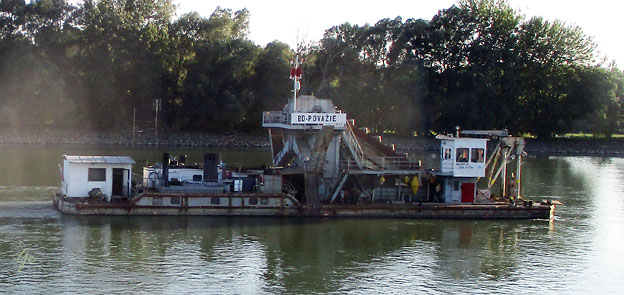
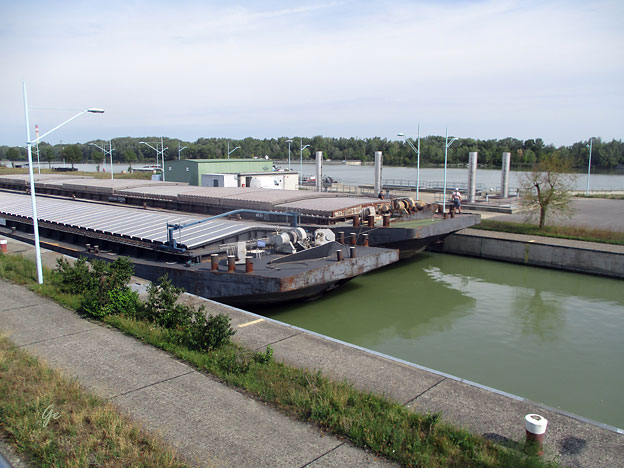
Sluser i Wien
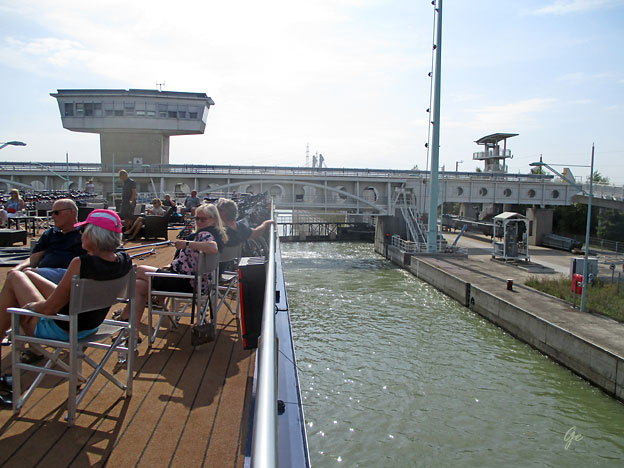
Sluser i Wien

Die Friedenspagode Wien ist ein buddhistischer Stupa, der an der Donau in Wien
liegt. Sie ist eine von rund 80 Friedenspagoden, die es weltweit gibt (Stand 2011).
Der Bau des Stupas erfolgte zwischen 1982 und 1983 nach Plänen des Architekten
Franz Richard Schnabel und wurde von japanischen Mönchen des Nipponzan-Myōhōji-Ordens ausgeführt. Die Eröffnungszeremonie fand am 25. September 1983, unter Anwesenheit des Gründers des Nipponzan-Myōhōji-Ordens Nichidatsu Fujii
(藤井日達; 1885–1985) sowie Vertretern verschiedener buddhistischer Orden und Traditionen, statt.
Der Stupa ist rund 26 Meter hoch. Die zentrale Buddha-Figur stellt Buddha
Shakyamuni dar, die 7 Reliefs stellen Szenen aus dem Leben des Religionsgründers Siddhartha Gautama dar – von der Geburt, über das Erwachen, die Lehrtätigkeit bis
zum Tod.
Friedenspagode Wien – Wikipedia
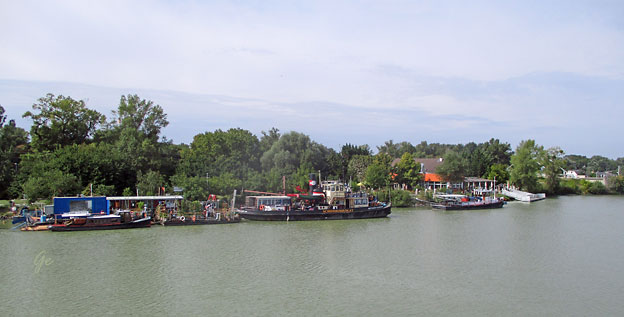
Wien Schiff Museum
Vienna is the capital, largest city, and one of nine states of Austria. Vienna is Austria's
most populous city, with about two million inhabitants (2.9 million within the
metropolitan area, nearly one third of the country's population), and its cultural,
economic, and political center. It is the 6th-largest city proper by population in the
European Union and the largest of all cities on Danube river.
Evidence has been found of continuous habitation in the Vienna area since 500 BC, when Celts settled the site on the Danube. In 15 BC, the Romans fortified the frontier
city they called Vindobona to guard the empire against Germanic tribes to the north.
In 1804, during the Napoleonic Wars, Vienna became the capital of the newly formed
Austrian Empire. The city continued to play a major role in European and world politics, including hosting the Congress of Vienna in 1814–15. The city also saw major uprisings against Habsburg rule in 1848, which were suppressed. After the Austro-Hungarian Compromise of 1867, Vienna remained the capital of what became the Austro-Hungarian Empire. The city functioned as a center of classical music, for which the title of the First Viennese School (Haydn/Mozart/Beethoven) is sometimes applied.
Vienna - Wikipedia
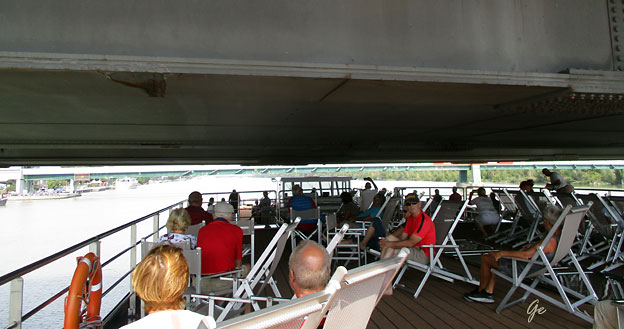
Lav bro
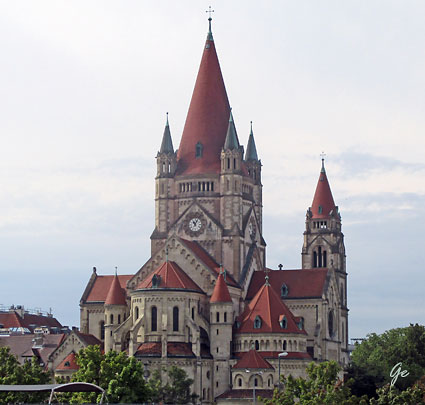 St. Francis of Assisi Church Built between 1898 and 1910, it was consecrated in 1913. The construction of the church celebrated the 50th anniversary of the reign of Emperor Franz Joseph I of Austria St. Francis of Assisi Church, Vienna - Wikipedia |
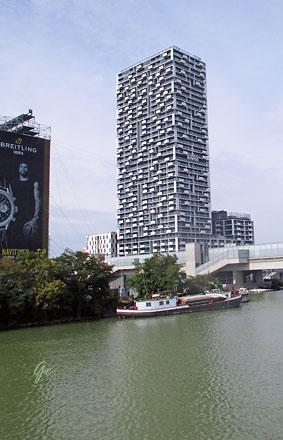 |
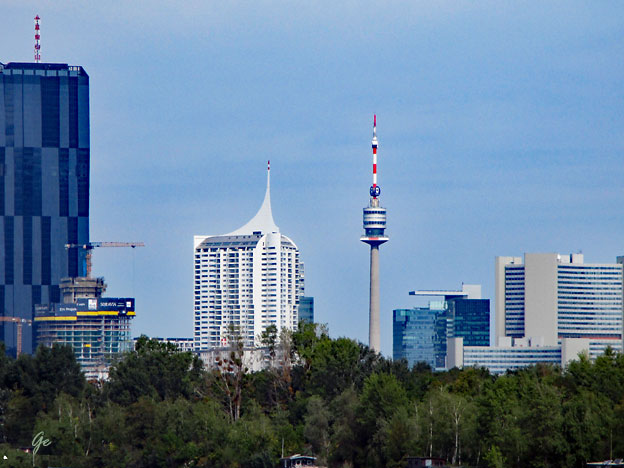
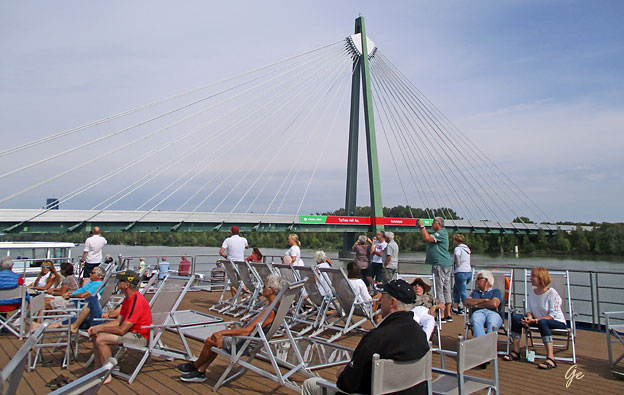

Cruiseskipene Moldova og Ukraina
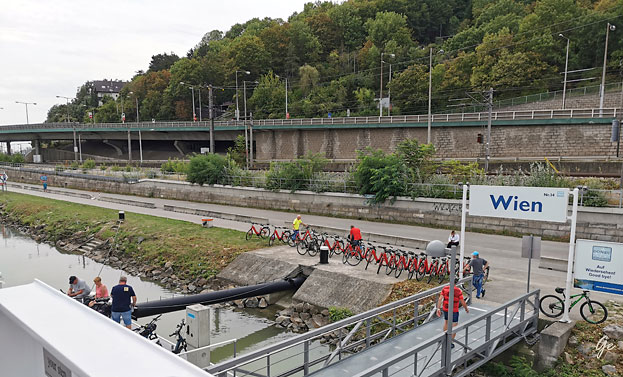
 Bilde fra: Müllverbrennungsanlage Spittelau – Wikipedia |
Die Müllverbrennungsanlage
Spittelau ist eine von drei thermischen Abfallbehandlungsanlagen der Wien Energie. Ihre Besonderheit liegt in der von Friedensreich Hundertwasser künstlerisch gestalteten Fassade. Mit einer installierten Gesamtleistung von 460 MW stellt die Anlage den zweitgrößten Erzeuger im Fernwärmeverbundnetz (diesen geringen Teil von 22 Prozent teilen sich die drei thermischen Abfallbehandlungsanlagen der Wien Energie) der Stadt Wien dar. Müllverbrennungsanlage Spittelau – Wikipedia |

Langs Donau-kanal
concepts of artist Friedensreich Hundertwasser during the years 1990 and 1991.
The building was used as car tyre factory before that time. The flood of people
visiting the nearby Hundertwasserhouse led to the idea of constructing a house
giving the infrastructure for the visitors.
Friedensreich Hundertwasser at the opening of Hundertwasser Village:*
“With the Village for my friend Kalke I realized another piece of a more human
and nature orientated architecture. I have been working as a doctor for
architecture so to say. We did not tear down and rebuild it but used existing
building fabric and improved it by changing and adding to the building and
inserting components with new shapes and colours.”
“On the roof a forest sprouts much to the pleasure of the neighbours (…) and
inside something like a romantic, narrow, oriental bazar exists where you like
to linger for a while.”
More than two decades later quite a forest has truly evolved on the roof of the
house. About 30 trees have grown up to 15 meters high housing many birds.
And inside the bazar is still there and about 1,2 million visitors admire
Hundertwassers concepts of interior design every year.
We are open 365 days a year and admission is free.
About the Hundertwasser Village (hundertwasser-village.com)
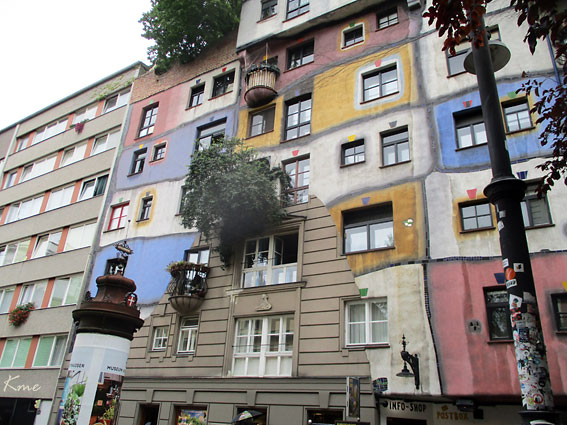
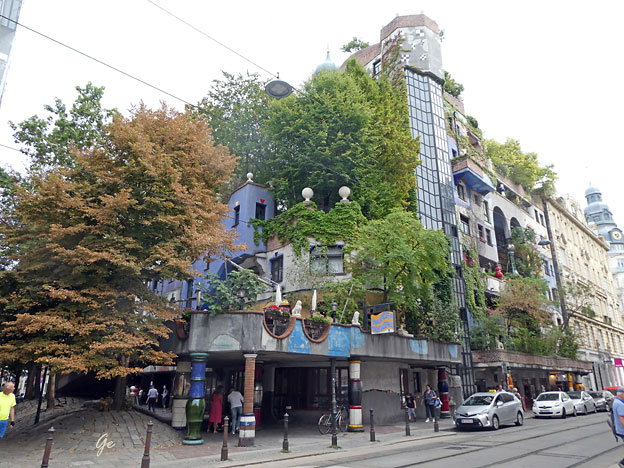
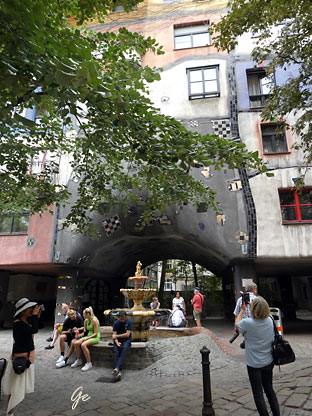 |
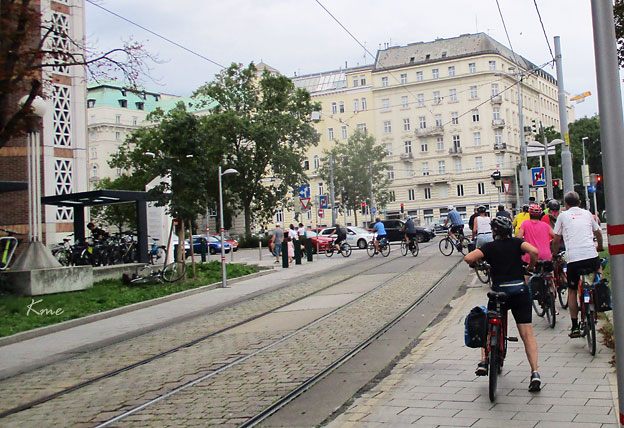
Her er vi på guida sykkeltur i Wien sentrum.
| Johann
Baptist Strauss II (25 October 1825 –
3 June 1899) was an Austrian
composer of light music,
particularly dance
music and operettas. He composed over
500 waltzes, polkas, quadrilles,
and other types of dance music, as well as
several operettas and a ballet. In his lifetime,
he was known as "The Waltz King", and was
largely responsible for the popularity of the
waltz in Vienna during the 19th
century. Some of Johann Strauss's most famous
works include "The Blue Danube", "Kaiser-Walzer"
(Emperor Waltz), "Tales from the Vienna Woods",
"Frühlingsstimmen", and the |
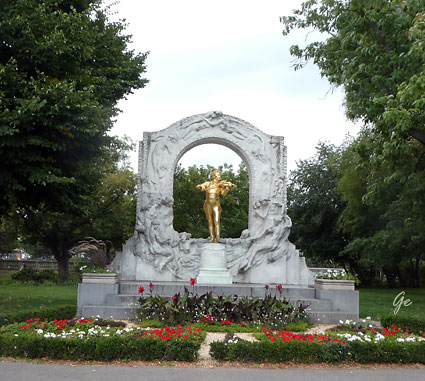 |
are the best known.
Strauss was the son of Johann Strauss I and his first wife Maria Anna Streim. Two younger brothers, Josef and Eduard Strauss, also became composers of light music, although they
were never as well known as their brother.
Johann Strauss II - Wikipedia

Bildet er tatt fra Byparken (Stadtpark)


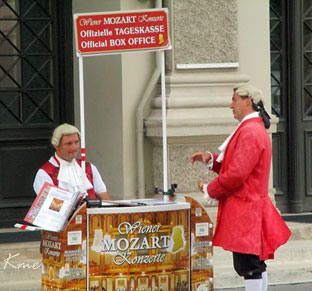 |
The Wiener Musikverein
, commonly shortened to Musikverein, is a concert hall in Vienna, Austria, which is located in the Innere Stadt district. The building opened in 1870 and is the home of the Vienna Philharmonic orchestra. The acoustics of the building's 'Great Hall' (Großer Saal) have earned it recognition alongside other prominent concert halls, such as the Konzerthaus in Berlin, the Concertgebouw in Amsterdam and Symphony Hall in Boston. With the exception of Boston's Symphony Hall, none |
acoustics, and all share a long, tall and narrow shoebox shape.
Musikverein - Wikipedia
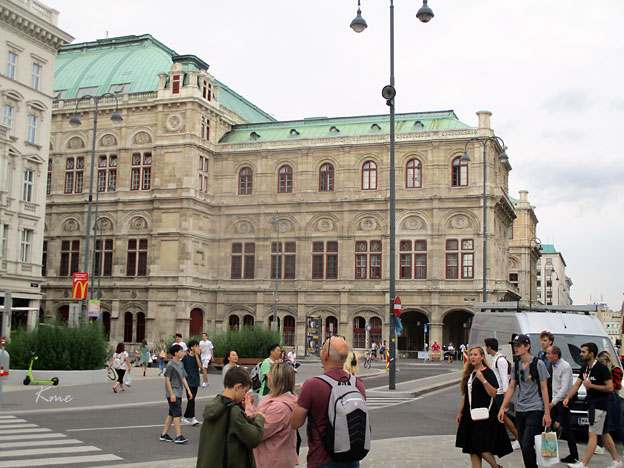
Austria. The 1,709-seat Renaissance Revival venue was the first major building
on the Vienna Ring Road. It was built from 1861 to 1869 following plans by
August Sicard von Sicardsburg and Eduard van der Nüll, and designs by Josef
Hlávka. The opera house was inaugurated as the "Vienna Court Opera" (Wiener
Hofoper) in the presence of Emperor Franz Joseph I and Empress Elisabeth of
Austria. It became known by its current name after the establishment of the
First Austrian Republic in 1921. The Vienna State Opera is the successor of the
Vienna Court Opera, the original construction site chosen and paid for by
Emperor Franz Joseph in 1861.
The members of the Vienna Philharmonic are recruited from the Vienna State
Opera's orchestra. The building is also the home of the Vienna State Ballet, and
it hosts the annual Vienna Opera Ball during the carnival season.
Towards the end of World War II, on 12 March 1945, the opera was set alight by
an American bombardment.The auditorium and stage were destroyed by flames,
as well as almost the entire décor and props for more than 120 operas with around
150,000 costumes. The front section, which had been walled off as a precaution,
however, remained intact including the foyer, with frescoes by Moritz von Schwind,
the main stairways, the vestibule and the tea room. The State Opera was temporarily
housed at the Theater an der Wien and at the Vienna Volksoper.
Vienna State Opera - Wikipedia
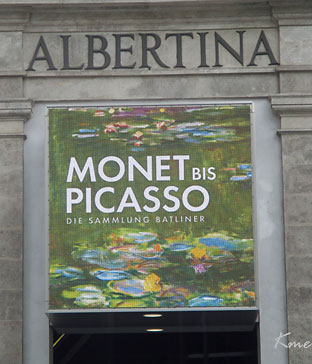 |
The
Albertina houses one of Europe’s most important compilations of Modernist art in the form of the Batliner Collection. Its permanent display starts off with such artists of Impressionism and Post-Impressionism as Degas, Cézanne, Toulouse-Lautrec, and Gauguin. Further highlights include examples of German Expressionism, with the groups of Brücke and Der Blaue Reiter, and the art of New Objectivity, with works by Wacker, Sedlacek, and Hofer. An in-depth focus on Austrian art comprises works by Kokoschka and paintings by Egger-Lienz. The great diversity of the Russian avant-garde is |
The presentation is topped off by numerous chefs-d’oeuvre by Picasso, ranging from
his early Cubist pictures and works from his mature period of the 1940s to superb
prints that have not yet been exhibited and paintings from his experimental late period.
Monet to Picasso. The Batliner Collection « The ALBERTINA Museum Vienna
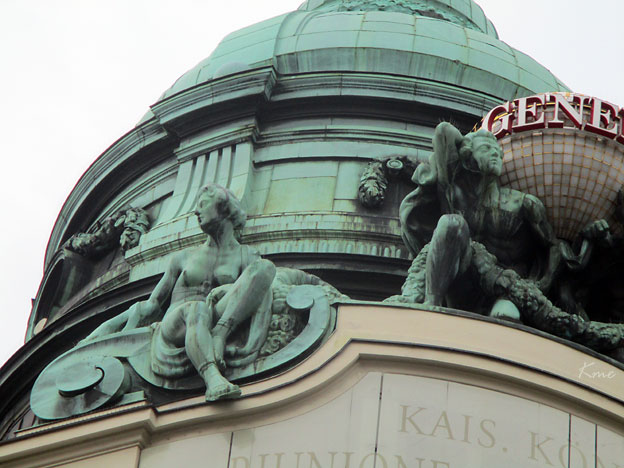
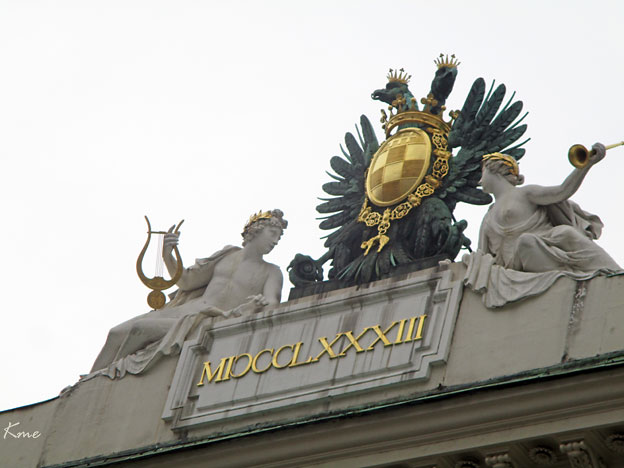

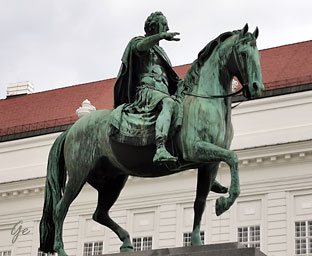 |
The
emperor at the time when Josefsplatz reached
its final form was Joseph II, which
explains the name (albeit with idiosyncratic
spelling). Joseph himself dominates the centre of the square with a monument in his honour, completed in 1807 just a few years after his 1790 death. If the design seems familiar, that might be because it mirrors the famous equestrian statue of Marcus Aurelius in Rome. Josefsplatz square (visitingvienna.com) |
The library is located in the Neue Burg Wing of the Hofburg in center of Vienna.
Since 2005, some of the collections have been relocated within the Baroque structure
of the Palais Mollard-Clary. Founded by the Habsburgs, the library was originally
called the Imperial Court Library (German: Kaiserliche Hofbibliothek); the change to
the current name occurred in 1920, following the end of the Habsburg Monarchy and
the proclamation of the Austrian Republic. The library complex includes four
museums, as well as multiple special collections and archives.
Austrian National Library - Wikipedia
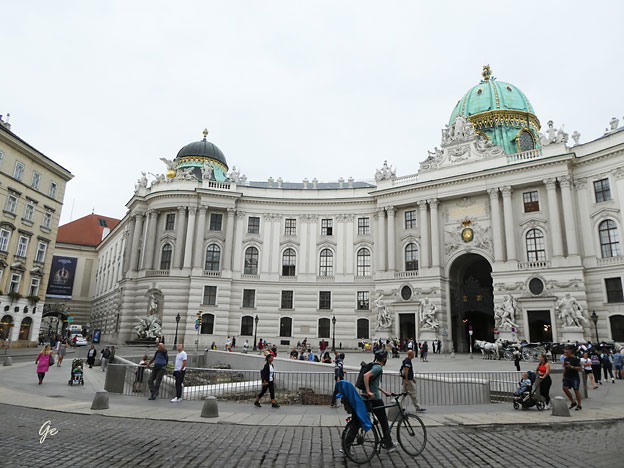
Hofburg sett fra Michaeler Platz
The Hofburg is the former principal imperial palace of the Habsburg dynasty.
Located in the centre of Vienna, it was built in the 13th century and expanded
several times afterwards. It also served as the imperial winter residence, as
Schönbrunn Palace was the summer residence. Since 1946 it is the official residence and workplace of the president of Austria.
Since 1279 the Hofburg area has been the documented seat of government.
The Hofburg has been expanded over the centuries to include various residences
(with the Amalienburg and the Albertina), the imperial chapel (Hofkapelle or
Burgkapelle), the imperial library (Hofbibliothek), the treasury (Schatzkammer), the Burgtheater, the Spanish Riding School (Hofreitschule), the imperial mews (Stallburg and Hofstallungen).
The palace faces the Heldenplatz (Heroes Square) ordered under the reign of
Emperor Franz Joseph I, as part of what was planned to become the Kaiserforum
[de] but which was never completed.
Numerous architects have executed work at the Hofburg as it expanded, notably the
Italian architect-engineer Filiberto Luchese, Lodovico Burnacini and Martino and
Domenico Carlone, the Baroque architects Lukas von Hildebrandt and Joseph
Emanuel Fischer von Erlach, Johann Fischer von Erlach, and the architects of the
Neue Burg built between 1881 and 1913.
Equestrian statues of the two most important Austrian field marshals, Prince Eugene
of Savoy and Archduke Charles, stand at the foci of Heroes Square. On 15 March 1938
Adolf Hitler proclaimed from the balcony of the New Castle onto Heroes' Square the "Anschluss" of Austria into the Nazi Third Reich.
Hofburg - Wikipedia
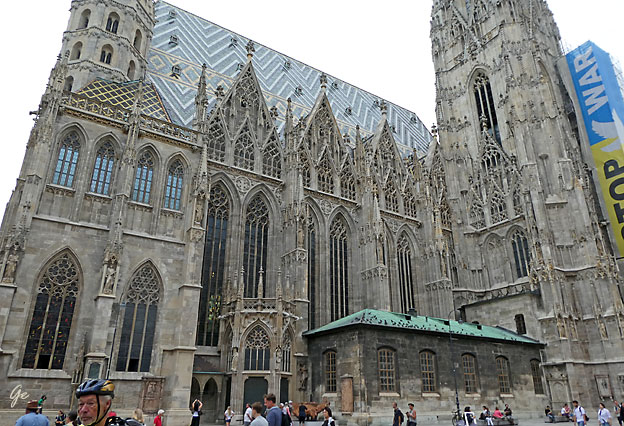
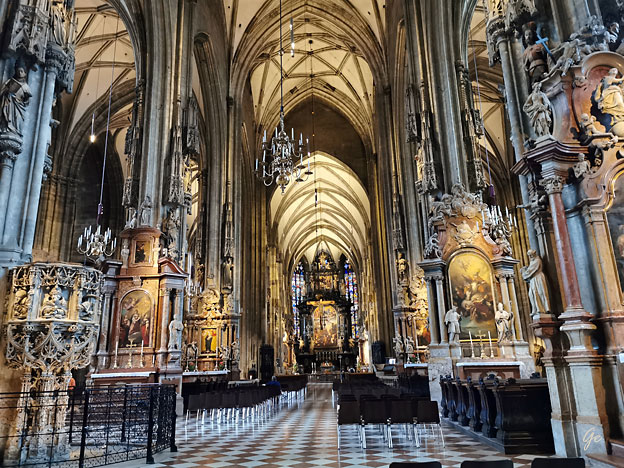
Catholic Archdiocese of Vienna and the seat of the Archbishop of Vienna, Christoph
Cardinal Schönborn, OP. The current Romanesque and Gothic form of the cathedral,
seen today in the Stephansplatz, was largely initiated by Duke Rudolf IV (1339–1365)
and stands on the ruins of two earlier churches, the first a parish church consecrated
in 1147. The most important religious building in Vienna, St. Stephen's Cathedral has
borne witness to many important events in Habsburg and Austrian history and has,
with its multi-coloured tile roof, become one of the city's most recognizable symbols.
By the middle of the 12th century, Vienna had become an important centre of
German civilization, and the four existing churches, including only one parish
church, no longer met the town's religious needs. In 1137, Bishop of Passau
Reginmar and Margrave Leopold IV signed the Treaty of Mautern, which
referred to Vienna as a civitas for the first time and transferred St. Peter's
Church to the Diocese of Passau.
Under the treaty, Margrave Leopold IV also
received from the bishop extended stretches of land beyond the city walls, with
the notable exception of the territory allocated for the new parish church, which
would eventually become St. Stephen's Cathedral. Although previously believed
built in an open field outside the city walls,
dating to Ancient Roman times; excavations for a heating system in 2000
revealed graves 2.5 metres (8.2 ft) below the surface, which were
carbon-dated to the 4th century. This discovery suggests that an even older
religious building on this site predated the St. Rupert's Church, which is
considered the oldest church in Vienna.
Founded in 1137 following the Treaty of Mautern, the partially constructed
Romanesque church was solemnly dedicated in 1147 to Saint Stephen in the
presence of Conrad III of Germany, Bishop Otto of Freising, and other German
nobles who were about to embark on the Second Crusade. Although the first
structure was completed in 1160, major reconstruction and expansion lasted
until 1511, and repair and restoration projects continue to the present day.
From 1230 to 1245, the initial Romanesque structure was extended westward;
the present-day west wall and Romanesque towers date from this period. In 1258,
however, a great fire destroyed much of the original building, and a larger
replacement structure, also Romanesque in style and reusing the two towers, was
constructed over the ruins of the old church and consecrated 23 April 1263.
The anniversary of this second consecration is commemorated each year by a rare
ringing of the Pummerin bell for three minutes in the evening.
St. Stephen's Cathedral, Vienna - Wikipedia
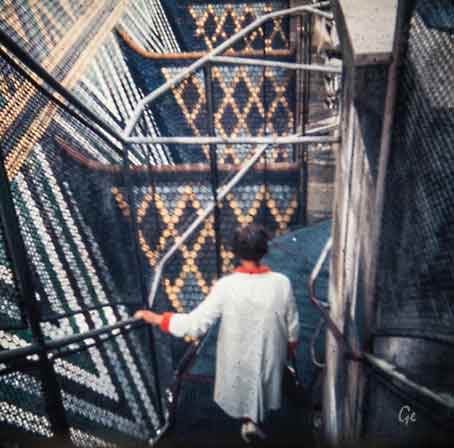 |
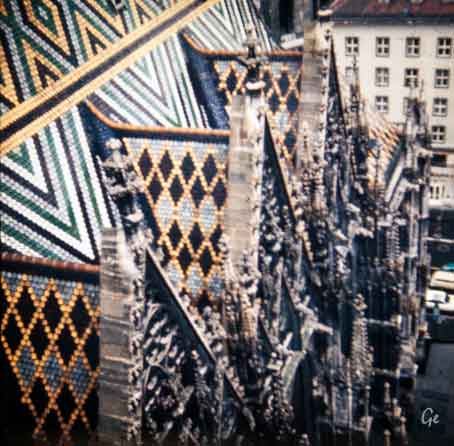 |
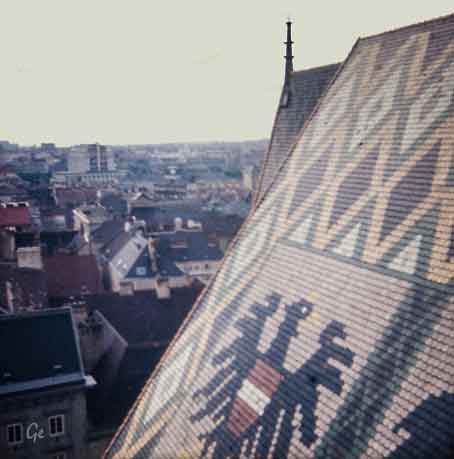 |
3 bilder fra Stephansdomen i 1969. Den gang kom man opp i tårnet via trapper på utsiden av kirken. |
Fra programmet:
Den siste sykkeldagen er et av høydepunktene i løpet av cruiset.
Vi befinner oss nå i Wachaudalen, som står på UNESCOs verdensarvliste
og er et av de mest idylliske landskapene langs Donau.
På bakketoppene og langs elven ligger borgruiner og små landsbyer.
Oppover de frodige dalsidene dyrkes det aprikoser og vindruer.
Sykkelturen starter i Rossatz eller Dürnstein (avhengig av kaiplass)
og vi kan velge om vi vil sykle på øst- eller vestsiden av Donau.
Sykkelturen ender i den lille byen Pöchlarn, hvor skipet venter
I kveld er det festmiddag om bord,
Mens vi spiser, legger SE-Manon ut på siste etappe av cruiset.
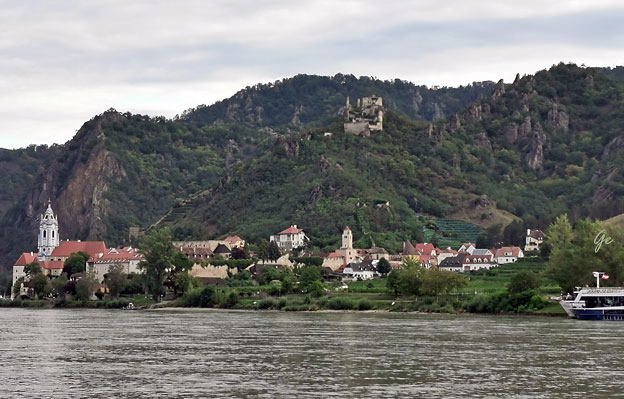
Dürnstein med borgen
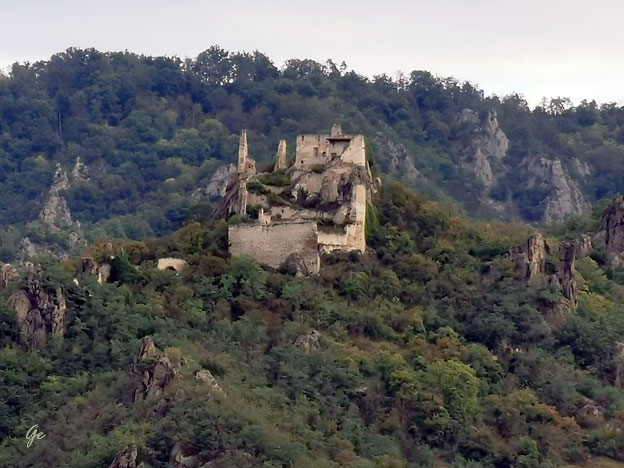
Dürnstein Castle
Dürnstein is a small town on the Danube river in the Krems-Land district, in the
Austrian state of Lower Austria. It is one of the most-visited tourist destinations in the Wachau region and also a well-known wine growing area. The municipality
consists of the Katastralgemeinden of Dürnstein, Oberloiben, and Unterloiben.
The town gained its name from the medieval Dürnstein castle, which overlooked it.
The castle's name derived from the German duerr/dürr, meaning "dry", and Stein,
"stone". The castle was dry because it was on a rocky hill, high above the damp
conditions of the Danube at the base of the hill, and it was built of stone. The
modern town stands between the castle and the river.
Dürnstein was first mentioned in 1192 when, in the castle above the town, King
Richard I of England was held captive by Leopold V, Duke of Austria, after their
dispute during the Third Crusade. Richard the Lionheart had offended Leopold the
Virtuous by casting down his standard from the walls at the Battle of Acre, and the
duke suspected that King Richard ordered the murder of his cousin Conrad of Montferrat in Jerusalem. In consequence Pope Celestine III excommunicated
Leopold for capturing a fellow crusader. The duke finally gave custody of the king
to Henry VI, Holy Roman Emperor, who imprisoned Richard at Trifels Castle.
Dürnstein - Wikipedia
down the Austrian flag on his return from the Crusades and refused to share the
spoils of war with Leopold V, Duke of Austria. As a consequence, Leopold V held
the King of England captive in the castle built by Hademar I of Kuenring in
Dürnstein (1192-1193). The royal prisoner was allowed to receive travelling
singers (troubadours) during his imprisonment, from which the saga of the singer
Blondel probably emerged.
by singing a stanza which the prisoner completed. Richard the Lionheart was released
upon payment of a ransom worth 150,000 silver marks. The ruins of Dürnstein are free
to visit all year round. If you are visiting the romantic ruins for the first time, you will
be rewarded with a stunning panoramic view. The proud castles and monasteries are
strung like diamonds on a necklace along the Wachau valley for you to enjoy.
The ruins of Dürnstein castle (lower-austria.info)
| Båten
vår la til i Rossatz. Vi ble anbefalt å sykle gjennom Dürnstein. Det var en veldig koselig by. Men for å komme ditt måtte vi enten bruke ferge, og det kunne være lang ventetid for å komme med. Alternativet var å sykle i motsatt retning av det vi egentlig skulle, til vi kom til en bro i Hundsheim. Det var en ekstratur på ca 12 km. Likevel valgte veldig mange det alternativet. Vi også tok de ekstra kilometerne. Sykkelveien ned ved elva er heldigvis flat og lettsykla. (Noen hadde venta 1 time på å komme med ferga) Bilde til høyre. Wintersperre. Betreten und Befahren auf eigene Gefahr |
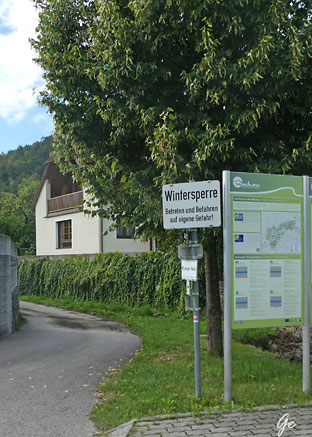 |
Storgata i Dürnstein. Sykling er forbudt, men turisttoget kommer seg fram. |
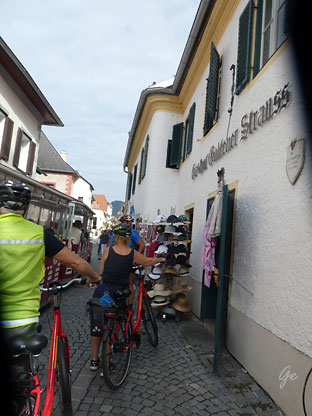 |
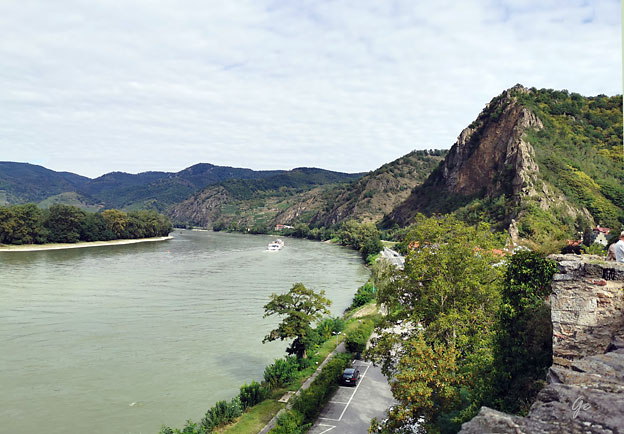
Donau sett fra Dürnstein. Det er båten vår S-Manon, som er på vei oppover elva.
Den skal plukke oss opp i Pöchlarn.
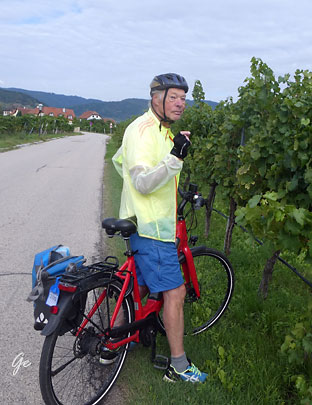 Karl Martin smaker på druene. |
Wachau is one
of Austria's most established and notable wine regions, specializing in dry wines made from Riesling and Grüner Veltliner. Located in Lower Austria along the Danube, west of Vienna and Krems an der Donau, it is one of the westernmost wine producing regions in Austria with only a few scattered plantings in Tyrol being further west. While most of Austria follows a wine classification systems based on ripeness and harvest must weight that parallels the German wine classification system, Wachau wines have a unique classification system. The three classification levels for Wachau wine include Steinfeder for wines up to 11.5% alcohol level, Federspiel for wines between 11.5–12.5% and Smaragd that |
small wine region that usually accounts for only around 3% of Austria's wine
production.
Wachau wine - Wikipedia
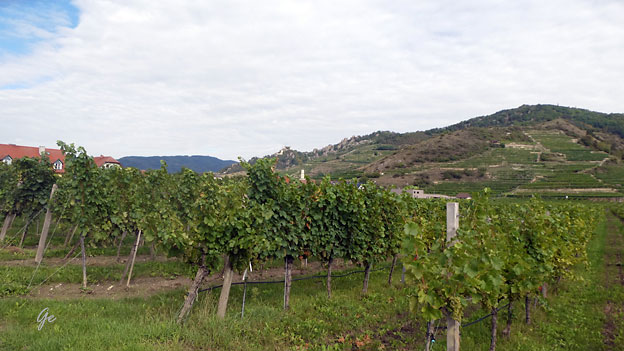
Vindruer i Wachadalen.
The statue of Richard Lionheart (to the right)
Despite well-reconstructed facts about the release of Richard Lionheart, Austrians like
to tell the story of the troubadour Blondel. According to the legend, Blondel was travelling through the Holy Roman Empire from castle to castle singing Lionheart’s favourite song in order to find him. Finally when he was performing his song in Dürnstein, Richard answered by singing the second verse. Thereupon Blondel arranged for Richard to be freed.
Richard Lionheart and Blondel | World Heritage Journeys of Europe (visitworldheritage.com) (25. august 2023)
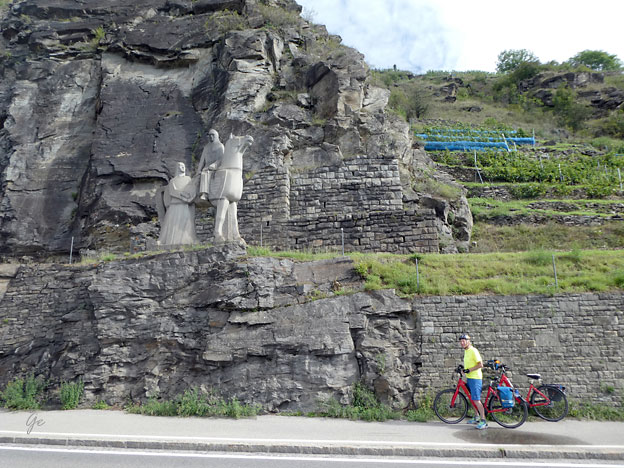
The modern statue depicting Richard the Lionhart sitting on a horse and the minstrel
who sang a song only Richard would know the words to.
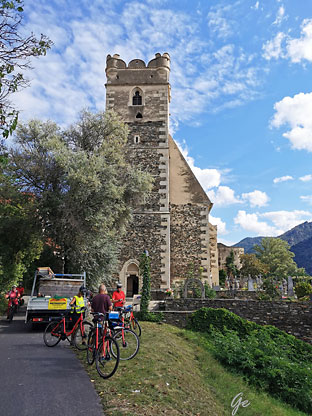 |
St.
Michel kirken Teksten til høyre er fra et skilt i kirken 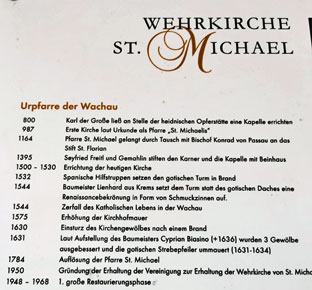 |
Urpfarre der Wachau
0800 Karl der Grosse lieb an Stelle der heidnischen Opferstätte eine Kapelle errichten
0987 Erste Kirche laut Urkunde als Pfarre "St. Michaelis"
1164 Pfarre St. Michael gelangt durch Tausch mit Bischof Konrad von Passau an das
Stift St. Florian.
1395 Seyfried Freitl und Gemahlin stiften den Karner und die Kapelle mit Beinhaus
1500 - 1530 Errichtung der heutigen Kirche
1532 Spanische Hilfstruppen setzen den gotischen Turm in Brand
1544 Baumeister Lienhard aus Krems setzt dem Turm statt des gotischen Daches
eine Renaissancebekrönung in Form von Schmuckzinnen auf.
1575 Erhöhungder Kirchhofmauer
1630 Einsturz des Kirchengewölbes nach einem Brand
1631 Laut Aufstellung des Baumeisters Cyprian Biasino (+1636) wurden 3
Gewölbe ausgebessert und die gotischen Strebepfeiler ummauert (1631-1634)
1784 Auflösung der Pfarre St. Michael
1950 Gründung der Erhaltung der Vereinigung zur Erhaltung der Wehrkirche
von St. Michael
1948- 1968 1. grosse Restaurierungphase
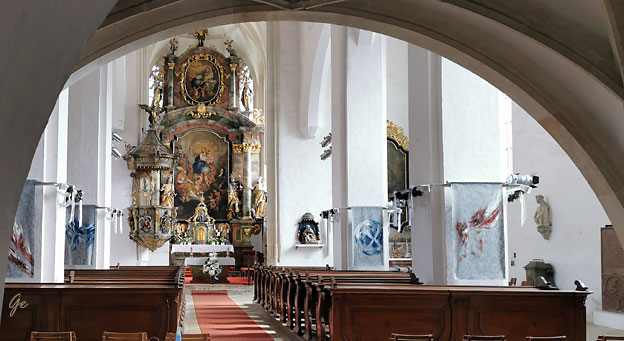
St. Michel kirken
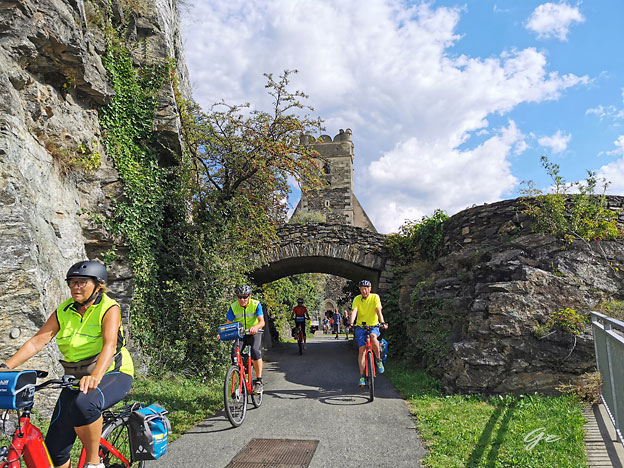
Wachaudalen ved Wehrkirche St-Michael
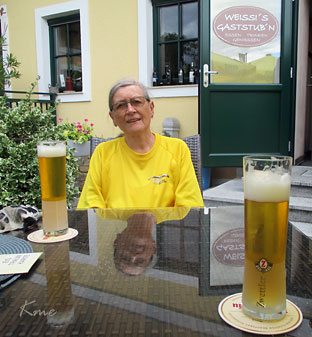 |
Uten mat og drikke ...... Mange syklister tok lunsjen sin på denne kafeen. Mens vi satt her fikk vi melding på telefonen om streik i Lufthansa og at flyet vi skulle hatt neste dag var instilt. |
Mange av syklistene, blant dem vi, sleit med å finne riktig vei ned til Melk.
Vi måtte over Donau. Det var greit, men etter kryssingen var det vanskelig
å finne sykkelveien videre.
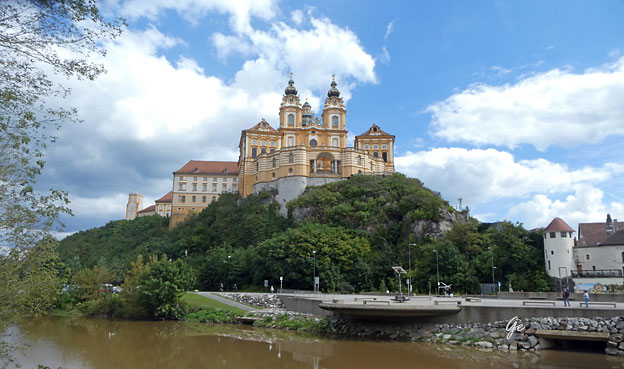
Melk Abbey (German: Stift Melk) is a Benedictine abbey above the town of Melk,
Lower Austria, Austria, on a rocky outcrop overlooking the Danube river, adjoining the Wachau valley. The abbey contains the tomb of Saint Coloman of Stockerau
and the remains of several members of the House of Babenberg, Austria's first ruling
dynasty.
Melk Abbey - Wikipedia
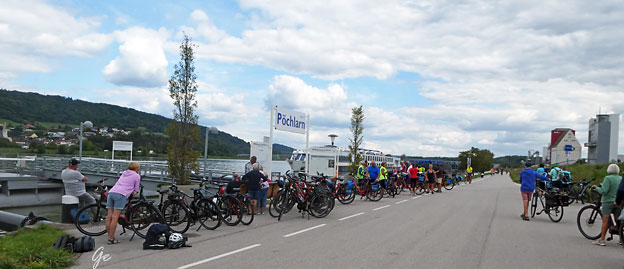
De fleste syklistene var i Pöchlarn før SE-Manon (skipet vårt).
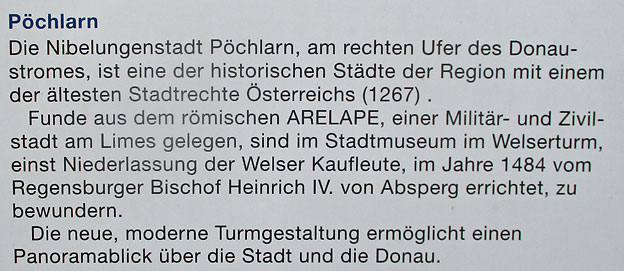
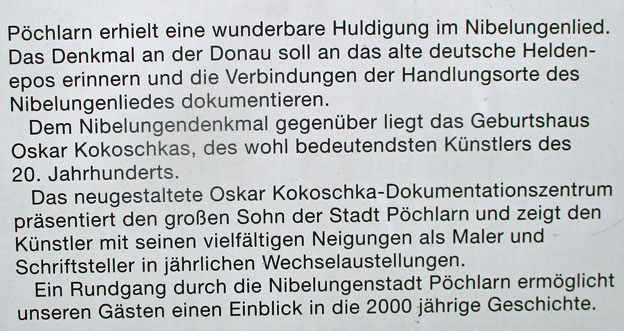
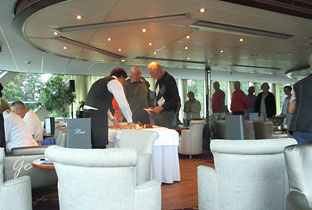 Klokka 16 00 ble det servert kake og kaffe (eller is og kaffe) |
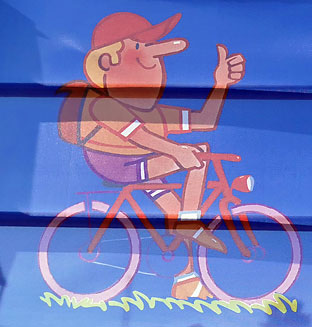 |
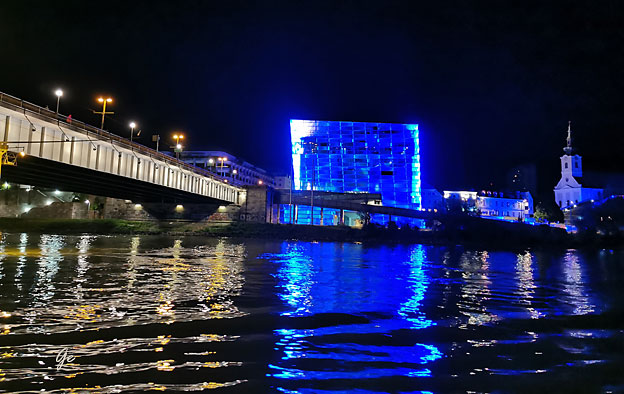
Vi passerer Linz
Fra programmet:
Vi ankommer Passau ved ti-tiden. Etter frokost tar vi farvel med skipet
og kjører med buss til flyplassen i München. Direktefly til Oslo.
Helt sånn ble det jo ikke.
Det var streik hos Lufthansa. Ingen flyvninger denne dagen.
Vi måtte forlate skipet kl 0900, og bussen til
München kom. I München fikk vi rom på flyplasshotell.
Det ble gjort forsøk på å skaffe rom i Münche sentrum,
men det var ikke plass til oss på noe hotell der.
Vi tok taxi inn til sentrum og fikk sett litt av München også.
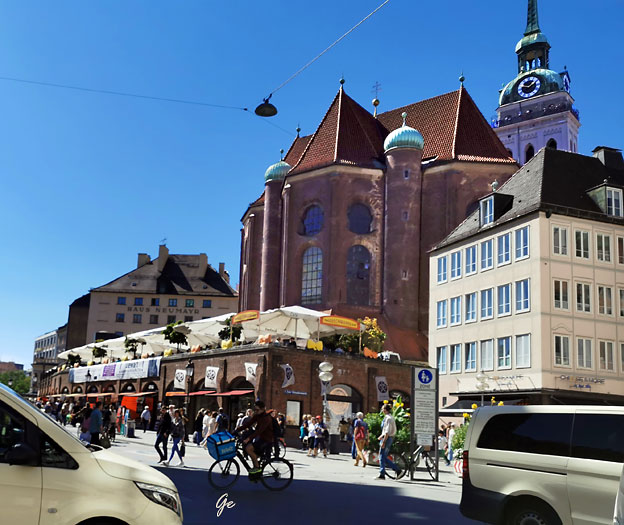 |
Munich
is the capital and most populous city of
the German state of Bavaria. With
a population of 1,558,395 inhabitants as of 31
July 2020, it is the third-largest city in Germany, after Berlin and Hamburg, and thus the largest which does not constitute its own state, as well as the 11th-largest city in the European Union. The city's metropolitan region is home to 6 million people. Straddling the banks of the River Isar (a tributary of |
after the Austrian capital of Vienna.
The city was first mentioned in 1158.
Munich - Wikipedia
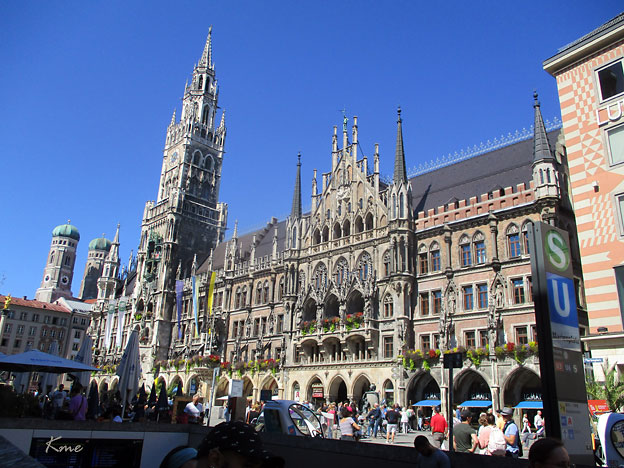
München Rathaus
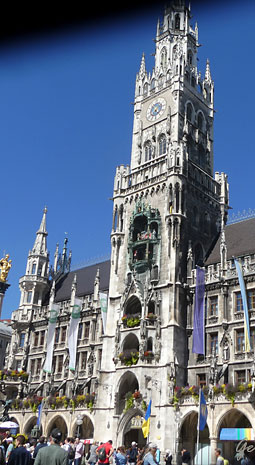 |
 |
the city council, offices of the mayors and a small portion of the administration.
In 1874 the municipality had left the Old Town Hall for its new domicile.
The decision to construct a new building came due to the lack of space in the Old
Town Hall and the adjoining, so-called "Lesser Town Hall" on Petersbergl (destroyed
in 1944, not reconstructed). In memory of the bourgeois high season during the
Gothic period, the choice fell upon a neo-Gothic design, which allowed an implement
an independent architectural accent in contrast to the buildings of the royal family.
The North side of the Marienplatz was chosen as the building site, where the house of the Landstände still stood which had been erected by the Bavarian Duke throughout
the Middle Ages as a sort of representation of the opposing Landstände. The first
section of the building in the Eastern part of the Marienplatz, on the corner of
Dienerstrasse, was the results of an idea competition won by Georg Hauberrisser and
carried out between 1867 and 1874. When it became clear that this new building
would not be able to accommodate the entire administration, the city began
purchasing all the properties on the Dienerstrasse, Landschaftstrasse and
Weinstrasse adjacent to the Town Hall started in 1887. From 1889 to 1892, the
section on the corner of Dienerstrasse and Landschaftstrasse was constructed.
New Town Hall (Munich) - Wikipedia
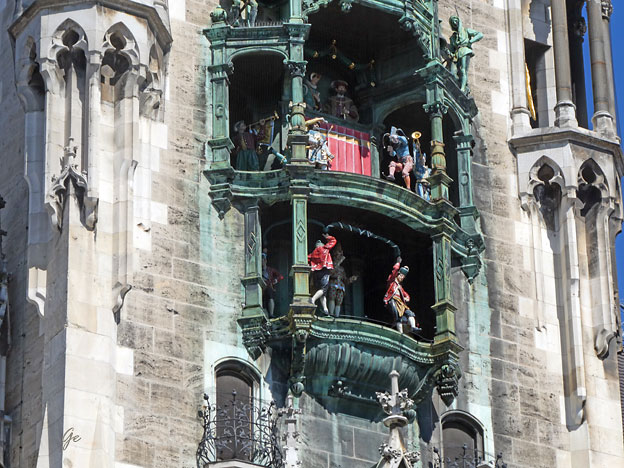
The Rathaus-Glockenspiel in Munich
the heart of Munich, Germany.
Part of the second construction phase of the New Town Hall, it dates from 1908.
Every day at 11 a.m. and 12 p.m. (as well as 5 p.m. in the summer) it chimes and
re-enacts two stories from the 16th century to the amusement of mass crowds of
tourists and locals. It consists of 43 bells and 32 life-sized figures. The top half of
the Glockenspiel tells the story of the marriage of the local Duke Wilhelm V (who
also founded the noted Hofbräuhaus) to Renata of Lorraine. In honor of the happy
couple there is a joust with life-sized knights on horseback representing Bavaria
(in white and blue) and Lothringen (in red and white). The Bavarian knight wins
every time, of course.
This is then followed by the bottom half and second story: Schäfflertanz (the
coopers' dance).
to have danced through the streets to "bring fresh vitality to fearful dispositions."
The coopers remained loyal to the duke, and their dance came to symbolize
perseverance and loyalty to authority through difficult times.
By tradition, the dance is performed in Munich every seven years. This was
described in 1700 as "an age-old custom", but the current dance was defined
only in 1871. The dance can be seen during Fasching (German Carnival): the
latest one is in 2019.
The whole show lasts somewhere between 12 and 15 minutes long depending on
which tune it plays that day. At the very end of the show, a very small golden
rooster at the top of the Glockenspiel chirps quietly three times, marking the end
of the spectacle.
Rathaus-Glockenspiel - Wikipedia
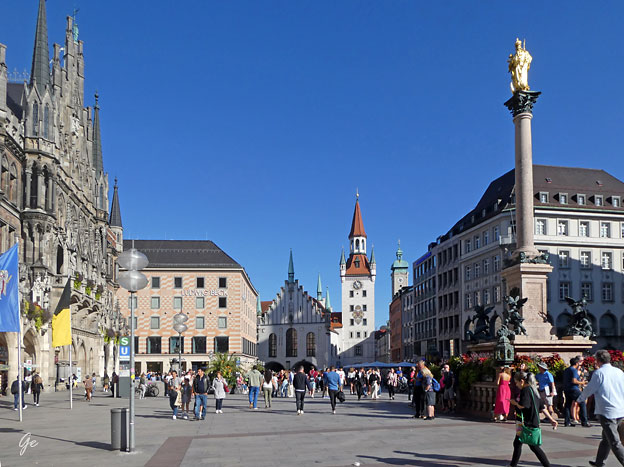
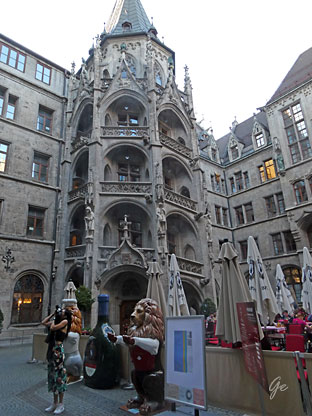 Rådhuset |
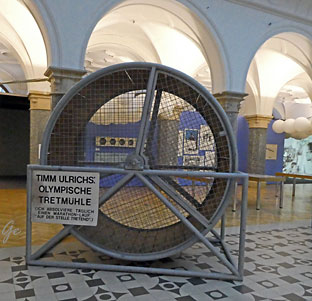 Fra en kunstutstilling i rådhuset |
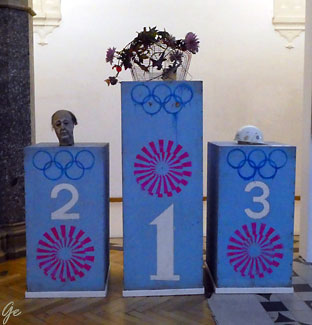 Fra en kunstutstilling i rådhuset |
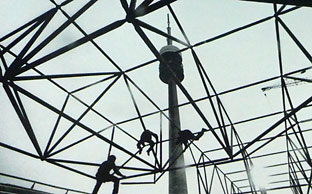 Fra en kunstutstilling i rådhuset Bildet viser bygging i forbindelse med OL 1972 |
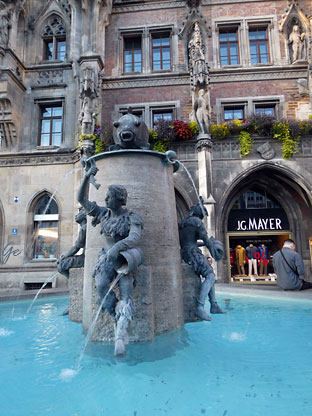 |
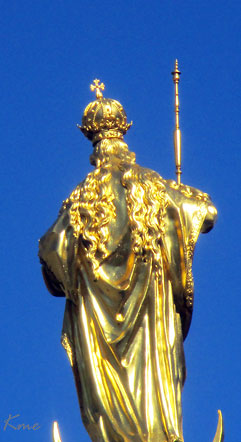 |
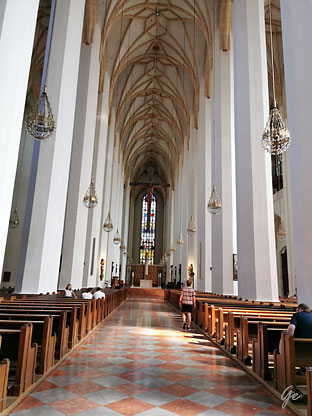 |
 |
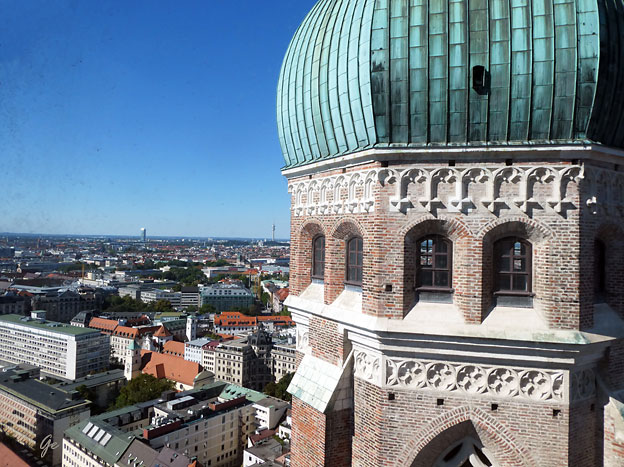
Fra tårnet i Frauenkirche
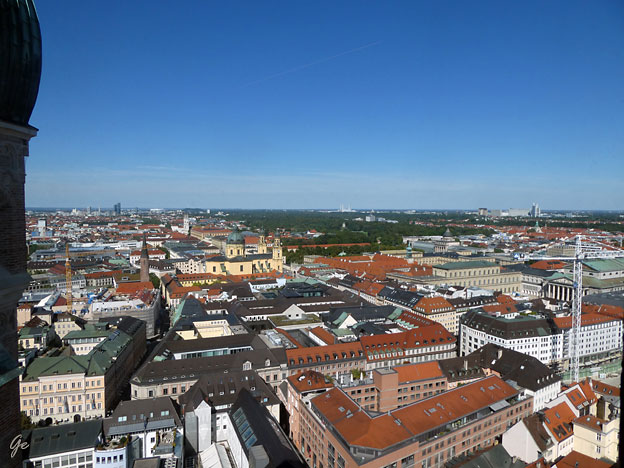
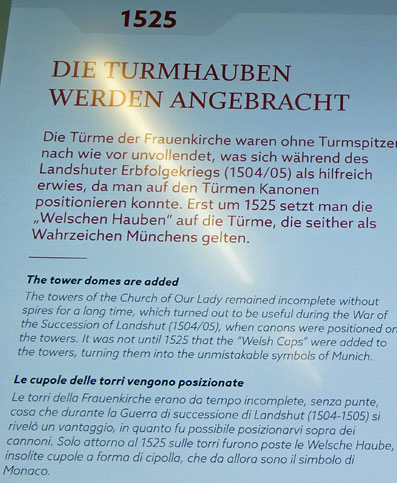 |
The Frauenkirche (Full
name: German: Dom zu Unserer Lieben Frau, lit. 'Cathedral of Our Dear Lady') is a church in Munich, Bavaria, Germany, that serves as the cathedral of the Archdiocese of Munich and Freising and seat of its Archbishop. It is a landmark and is considered a symbol of the Bavarian capital city. Although called "Münchner Dom" (Munich Cathedral) on its website and URL, the church is referred to as "Frauenkirche" by locals. Because of local height limits, the church towers are widely visible. As a result of the narrow outcome of a local plebiscite, city administration prohibits buildings with a height |
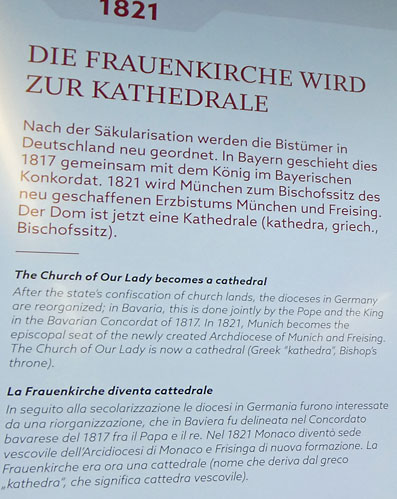 |
exceeding 99 m in the city
center. Since November 2004, this prohibition has been provisionally extended outward, and consequently, no buildings may be built in the city over the aforementioned height. The south tower, which is normally open to those wishing to climb the stairs, will offer a unique view of Munich and the nearby Alps after its current renovation is completed. Frauenkirche, Munich - Wikipedia |
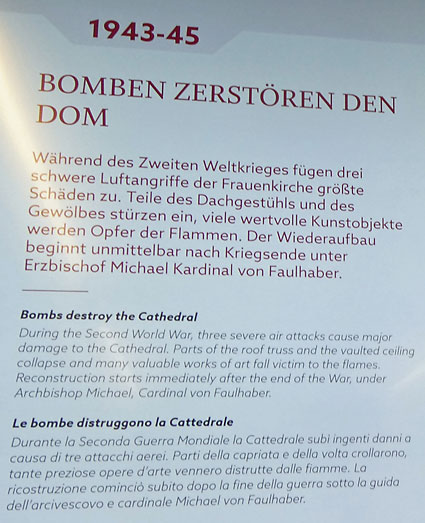 |
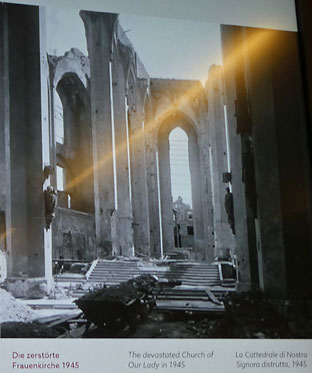 |
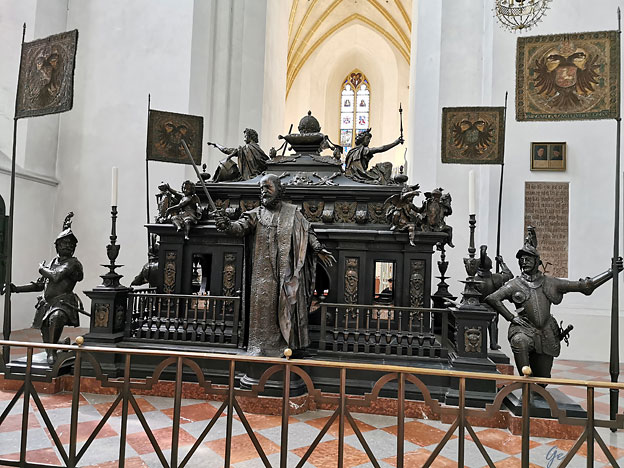
Cenotaph of Emperor Louis IV by Hans Krumpper
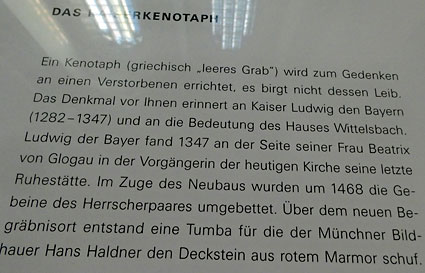 |
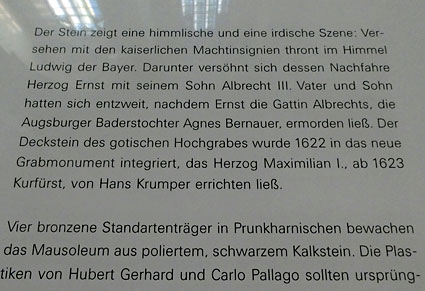 |
 |
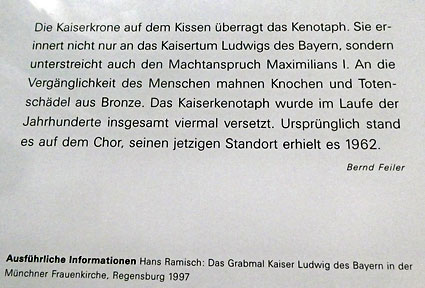 |
| The Old
Town Hall (German Altes
Rathaus), until 1874 the domicile of the municipality, serves today as a building for representative purposes for the city council in Munich. The Old Town Hall bounds the central square Marienplatz on its east side. The building, documented for the first time in 1310, had its Grand Hall (Großer Saal) constructed in 1392/1394. The former Talburg Gate (Talburgtor) of the first city wall serves as spire. The Old Town Hall was re-designed in late-gothic style by Jörg von Halsbach 1470–1480. The Grand Hall was decorated by the Morris dancers, created by Erasmus Grasser. After alterations of the facade during the Renaissance and again in the Baroque the building was restored in neo-gothic style 1861–1864. In 1874 the municipality moved to the New Town Hall. Old Town Hall, Munich - Wikipedia |
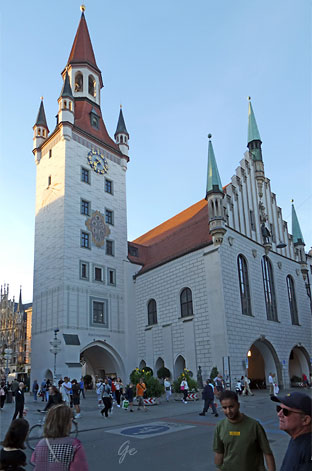 |

Heilig-Geist-Kirche (Church of the Holy Spirit; lit. 'Holy Ghost Church') is a Gothic
hall church in Munich, southern Germany, originally belonging to the Hospice of
the Holy Ghost (14th century).
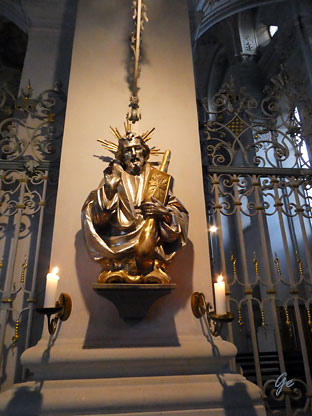  |
Jude (
was one of the Twelve
Apostles of Jesus according to the New Testament. Heilig-Geist-Kirche It was remodelled in 1724–30 by Johann Georg Ettenhofer [de] (vaults, renovation of pillars); in the interior are Rococo frescoes and stucco ornament by the Asam brothers. After the demolition of the hospice buildings in 1885, Franz Lšwel added three bays at the west end of the church and gave it a Neo-Baroque facade. The church suffered severe damage during World War II and its interior furnishings were largely destroyed; extensive rebuilding and restoration was carried out after the war. The interior of the church was renovated in 1991. Heilig-Geist-Kirche, Munich - Wikipedia |
Vi fikk nye flybilletter fra Lufthansa.
Klokka 1840 fra München til Zürich
og videre fra Zürich kl 2050.
Hjemme mellom 01-02 om natta
den 4. september
